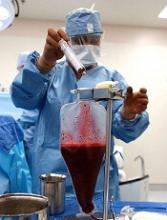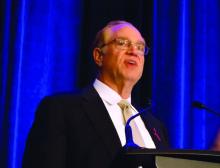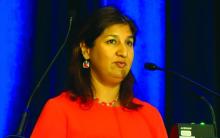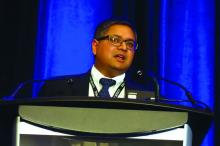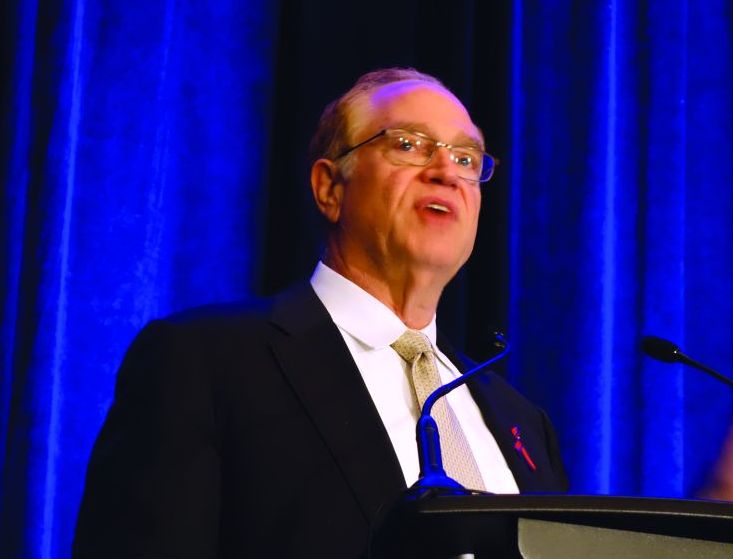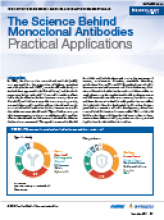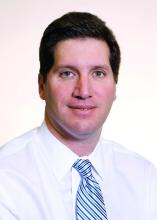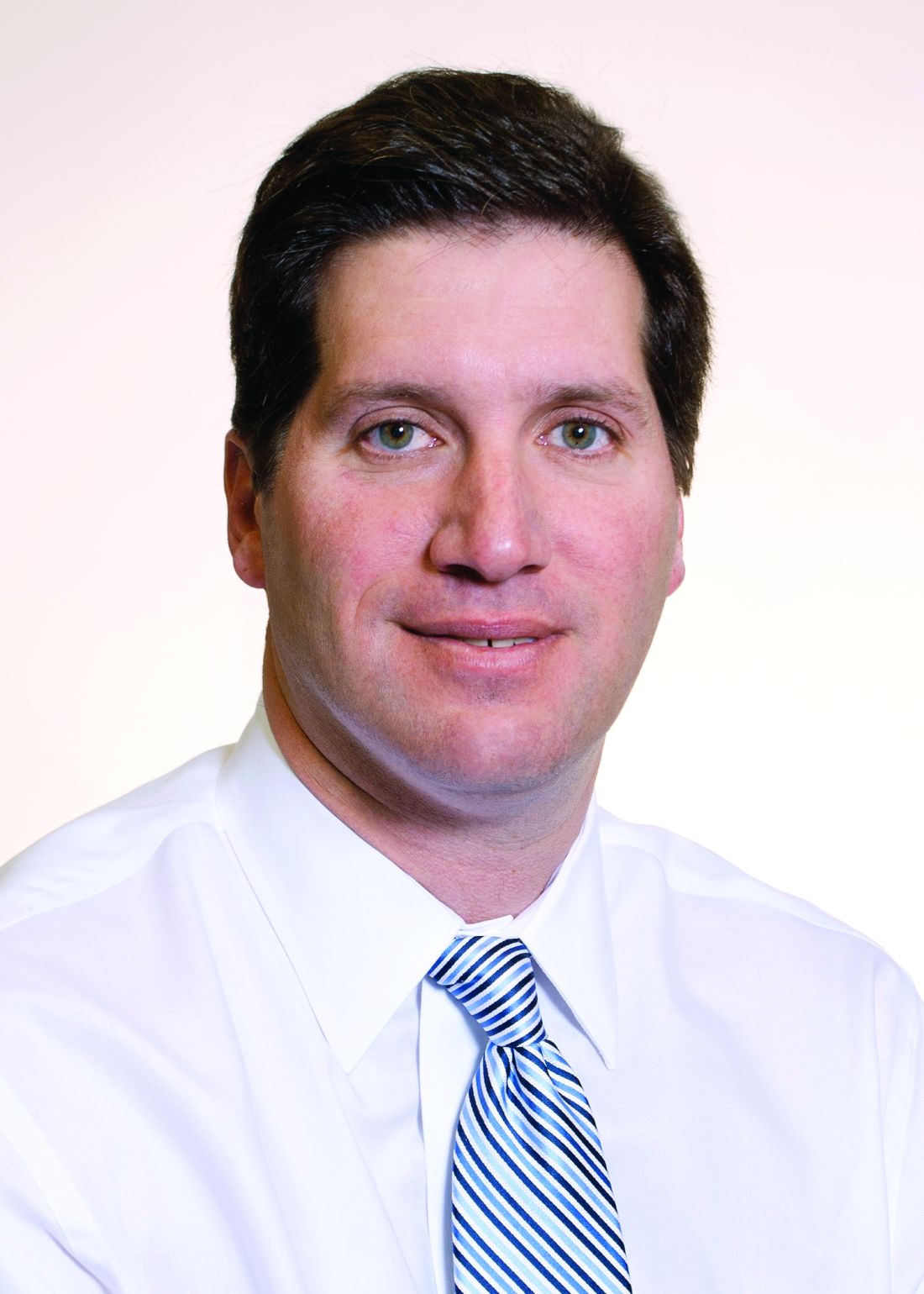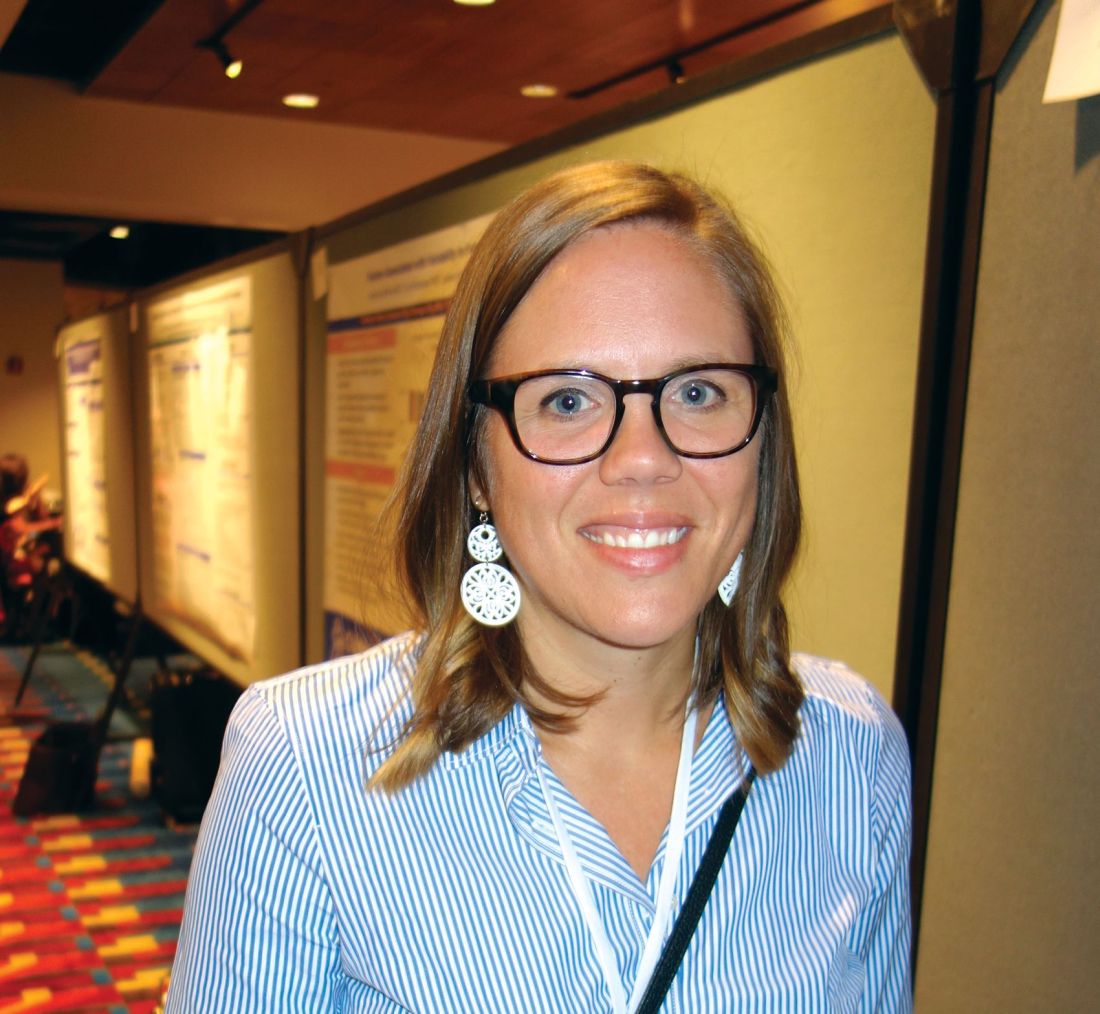User login
Orphan designation recommended for OMS721
The European Medicines Agency’s (EMA’s) Committee for Orphan Medicinal Products (COMP) has issued a positive opinion recommending orphan drug designation for OMS721 as a treatment for high-risk hematopoietic stem cell transplant-associated thrombotic microangiopathy (HSCT-TMA).
OMS721 is a monoclonal antibody targeting MASP-2, the effector enzyme of the lectin pathway of the complement system.
The COMP’s positive opinion of OMS721 for HSCT-TMA is expected to be adopted by the European Commission in August.
Orphan drug designation in Europe is available to companies developing products intended to treat a life-threatening or chronically debilitating condition that affects fewer than 5 in 10,000 people in the European Union (EU).
This designation allows for financial and regulatory incentives that include 10 years of marketing exclusivity in the EU after product approval, reduced EMA advisory, inspection and filing fees pre- and post-approval, and guaranteed access to centralized marketing authorization valid in all EU member states as well as in European Economic Area countries (ie, Iceland, Liechtenstein, and Norway).
Phase 2 trial
OMS721 is currently under evaluation in a phase 2 trial (NCT02222545). Omeros Corporation, the company developing OMS721, released some results from this study in February.
Results were reported for 18 adults with HSCT-TMA persisting for at least 2 weeks following immunosuppressive regimen modification or more than 30 days post-transplant. The patients received weekly OMS721 treatments for 4 to 8 weeks at the discretion of the investigator.
These patients had a significantly longer median overall survival than historical controls—347 days and 21 days, respectively (P<0.0001).
Omeros also reported that markers of TMA activity significantly improved following OMS721 treatment.
The mean platelet count increased from 18,100 x 106/mL at baseline to 52,300 x 106/mL (P=0.017). The mean LDH decreased from 591 U/L to 250 U/L (P<0.001). And the mean haptoglobin increased from 8 mg/dL to 141 mg/dL (P=0.003).
Mean creatinine remained stable—at approximately 120 μmol/L—but a majority of patients had co-existing conditions for which they were receiving nephrotoxic medications. These conditions included graft-versus-host disease, cytomegalovirus and human herpes virus 6 infections, prior sepsis, diffuse alveolar hemorrhage, and residual underlying malignancies.
The most commonly reported adverse events in this trial were diarrhea and neutropenia.
Four deaths occurred. One of these—due to acute renal and respiratory failure—was considered possibly related to OMS721.
The other deaths were due to progression of acute myeloid leukemia (n=1) and neutropenic sepsis (n=2).
The European Medicines Agency’s (EMA’s) Committee for Orphan Medicinal Products (COMP) has issued a positive opinion recommending orphan drug designation for OMS721 as a treatment for high-risk hematopoietic stem cell transplant-associated thrombotic microangiopathy (HSCT-TMA).
OMS721 is a monoclonal antibody targeting MASP-2, the effector enzyme of the lectin pathway of the complement system.
The COMP’s positive opinion of OMS721 for HSCT-TMA is expected to be adopted by the European Commission in August.
Orphan drug designation in Europe is available to companies developing products intended to treat a life-threatening or chronically debilitating condition that affects fewer than 5 in 10,000 people in the European Union (EU).
This designation allows for financial and regulatory incentives that include 10 years of marketing exclusivity in the EU after product approval, reduced EMA advisory, inspection and filing fees pre- and post-approval, and guaranteed access to centralized marketing authorization valid in all EU member states as well as in European Economic Area countries (ie, Iceland, Liechtenstein, and Norway).
Phase 2 trial
OMS721 is currently under evaluation in a phase 2 trial (NCT02222545). Omeros Corporation, the company developing OMS721, released some results from this study in February.
Results were reported for 18 adults with HSCT-TMA persisting for at least 2 weeks following immunosuppressive regimen modification or more than 30 days post-transplant. The patients received weekly OMS721 treatments for 4 to 8 weeks at the discretion of the investigator.
These patients had a significantly longer median overall survival than historical controls—347 days and 21 days, respectively (P<0.0001).
Omeros also reported that markers of TMA activity significantly improved following OMS721 treatment.
The mean platelet count increased from 18,100 x 106/mL at baseline to 52,300 x 106/mL (P=0.017). The mean LDH decreased from 591 U/L to 250 U/L (P<0.001). And the mean haptoglobin increased from 8 mg/dL to 141 mg/dL (P=0.003).
Mean creatinine remained stable—at approximately 120 μmol/L—but a majority of patients had co-existing conditions for which they were receiving nephrotoxic medications. These conditions included graft-versus-host disease, cytomegalovirus and human herpes virus 6 infections, prior sepsis, diffuse alveolar hemorrhage, and residual underlying malignancies.
The most commonly reported adverse events in this trial were diarrhea and neutropenia.
Four deaths occurred. One of these—due to acute renal and respiratory failure—was considered possibly related to OMS721.
The other deaths were due to progression of acute myeloid leukemia (n=1) and neutropenic sepsis (n=2).
The European Medicines Agency’s (EMA’s) Committee for Orphan Medicinal Products (COMP) has issued a positive opinion recommending orphan drug designation for OMS721 as a treatment for high-risk hematopoietic stem cell transplant-associated thrombotic microangiopathy (HSCT-TMA).
OMS721 is a monoclonal antibody targeting MASP-2, the effector enzyme of the lectin pathway of the complement system.
The COMP’s positive opinion of OMS721 for HSCT-TMA is expected to be adopted by the European Commission in August.
Orphan drug designation in Europe is available to companies developing products intended to treat a life-threatening or chronically debilitating condition that affects fewer than 5 in 10,000 people in the European Union (EU).
This designation allows for financial and regulatory incentives that include 10 years of marketing exclusivity in the EU after product approval, reduced EMA advisory, inspection and filing fees pre- and post-approval, and guaranteed access to centralized marketing authorization valid in all EU member states as well as in European Economic Area countries (ie, Iceland, Liechtenstein, and Norway).
Phase 2 trial
OMS721 is currently under evaluation in a phase 2 trial (NCT02222545). Omeros Corporation, the company developing OMS721, released some results from this study in February.
Results were reported for 18 adults with HSCT-TMA persisting for at least 2 weeks following immunosuppressive regimen modification or more than 30 days post-transplant. The patients received weekly OMS721 treatments for 4 to 8 weeks at the discretion of the investigator.
These patients had a significantly longer median overall survival than historical controls—347 days and 21 days, respectively (P<0.0001).
Omeros also reported that markers of TMA activity significantly improved following OMS721 treatment.
The mean platelet count increased from 18,100 x 106/mL at baseline to 52,300 x 106/mL (P=0.017). The mean LDH decreased from 591 U/L to 250 U/L (P<0.001). And the mean haptoglobin increased from 8 mg/dL to 141 mg/dL (P=0.003).
Mean creatinine remained stable—at approximately 120 μmol/L—but a majority of patients had co-existing conditions for which they were receiving nephrotoxic medications. These conditions included graft-versus-host disease, cytomegalovirus and human herpes virus 6 infections, prior sepsis, diffuse alveolar hemorrhage, and residual underlying malignancies.
The most commonly reported adverse events in this trial were diarrhea and neutropenia.
Four deaths occurred. One of these—due to acute renal and respiratory failure—was considered possibly related to OMS721.
The other deaths were due to progression of acute myeloid leukemia (n=1) and neutropenic sepsis (n=2).
Positive pivotal trials for new headache drugs abound
SAN FRANCISCO – After a lengthy drought in the development of major new headache medications, it was finally raining successful phase 3 clinical trials for novel drugs at the annual meeting of the American Headache Society.
From the podium, as a prelude to presenting one of many positive trials, Richard B. Lipton, MD, was moved to paraphrase Charles Dickens: “ ‘It was the best of times’ ... and these are truly the best of times,” the neurologist observed.
“This morning we’ve heard about seven new molecular entities that are effective in the acute and/or preventive treatment of migraine, a couple of novel ways of delivering older drugs, and some interesting comparative effectiveness research. I have this compulsion to say over and over again – because I also work in Alzheimer’s disease – it just isn’t like this in other fields. This is truly a remarkable time in our field,” observed Dr. Lipton, professor and vice chair of the department of neurology at Albert Einstein College of Medicine in New York.
In addition to new studies of erenumab-aooe, which has been approved as Aimovig, the first-in-class calcitonin gene-related peptide (CGRP) inhibitor for the preventive treatment of migraine, the headache meeting also featured new positive phase 3 results for three other anti-CGRP monoclonal antibodies – galcanezumab, fremanezumab, and eptinezumab – as migraine-preventive therapy, with galcanezumab also demonstrating efficacy in episodic cluster headache; the oral small-molecule CGRP antagonists rimegepant and ubrogepant for acute treatment of migraine attacks; and the selective serotonin 5-HT 1F agonist lasmiditan, also for acute treatment of migraine.
Although the mechanisms of action and therapeutic purposes of the novel agents differ, they share in common what appears to be far better safety and tolerability than the current market leaders, topiramate (Topamax) for migraine prevention and the triptans for acute treatment.
Here are study highlights for the three potential new treatments for acute migraine attacks:
Rimegepant
Dr. Lipton presented the results of two virtually identical phase-3, double-blind, randomized trials in which a total of 2,162 patients with episodic migraine self-administered a 75-mg oral tablet of rimegepant or placebo to treat a single migraine attack when their headache pain reached moderate or severe intensity. The clinical trials, which lacked the customary snazzy acronyms, were simply called Study 301 and Study 302.
The two co-primary endpoints now required by the Food and Drug Administration for candidate agents for acute treatment of migraine attacks are freedom from pain and absence of the most bothersome symptom, both as assessed 2 hours post dose. The oral CGRP receptor antagonist met both endpoints, as well as key secondary endpoints.
In Study 302, for example, the pain-free rate 2 hours post dose was 19.6% in the rimegepant group, significantly higher than the 12% rate in placebo-treated controls. The rate of freedom from the most bothersome symptom, which was photophobia in the majority of patients, was 37.6% in the rimegepant group and 25.2% with placebo.
Dr. Lipton characterized the benefits seen with a single dose of rimegepant as “broad and clinically important.”
“The majority of patients achieved pain relief, durability of benefit at 24 and 48 hours, lower use of rescue medications, and a greater proportion of patients achieved normal function,” the neurologist reported.
The safety and tolerability profiles of rimegepant mirrored those of placebo, he added.
Ubrogepant
Dr. Lipton also presented the results of ACHIEVE II, a multicenter, double-blind, phase 3, placebo-controlled study of the oral CGRP receptor antagonist ubrogepant at 25 or 50 mg versus placebo in 1,355 patients with episodic migraine. Like rimegepant, it met both FDA-required primary endpoints. The pain freedom rate 2 hours post dose was 20.7% with ubrogepant at 25 mg, 21.8% with 50 mg, and 14.3% with placebo. The most bothersome symptom was gone at 2 hours in 34.1% of patients who received the CGRP receptor antagonist at 25 mg, 38.9% of those who got the 50-mg dose, and 27.4% of controls.
David W. Dodick, MD, explained the rationale for CGRP inhibition: CGRP and its receptors are highly expressed in pain-sensitive trigeminal sensory neurons, which innervate the dura and meningeal blood vessels. During the headache phase of migraine, the peptide is released in excess, making CGRP a key player in the pathophysiology of migraine.
Dr. Dodick presented an update focused on secondary endpoints in the phase 3, double-blind ACHIEVE I trial, whose positive co-primary outcomes have previously been reported. The analysis included 1,327 episodic migraine patients who were randomized to ubrogepant at 50 or 100 mg or placebo. Among the notable secondary outcomes was the clinically important rate of pain relief at 2 hours: 61% in both ubrogepant groups, significantly better than the 49% rate with placebo. Also, in terms of pain freedom, the 2-hour rate underestimated the true efficacy patients would experience in clinical practice: the maximum pain freedom rate occurred at 3 hours and was sustained to 8 hours post dose.
At the time study participants took their pill, only 30% indicated they were capable of functioning normally. Two hours later, this was still the case in 29.8% of placebo-treated controls, as compared with 40.6% on ubrogepant at 50 mg and 42.9% who took 100 mg of the drug. The proportion of patients who said they were satisfied or extremely satisfied with their treatment at the 2-hour mark was 24.1% in the placebo arm and 36.3% and 35.8% in the lower- and higher-dose ubrogepant arms, reported Dr. Dodick, professor of neurology at the Mayo Clinic in Scottsdale, Ariz.
Lasmiditan
Sheena K. Aurora, MD, presented the results of SAMURAI and SPARTAN, two randomized, double-blind, phase 3 clinical trials comparing lasmiditan versus placebo for the treatment of acute migraine in a collective 3,701 patients with longstanding episodic migraine, one-third of whom had a history of aura.
Lasmiditan is a novel oral serotonin receptor agonist that penetrates the CNS and selectively targets the 5-HT 1F receptor. The drug doesn’t cause the vasoconstrictive effects that make triptans, which target 5-HT 1B/1D receptors, contraindicated in patients with cardiovascular disease.
Indeed, SPARTAN included patients with known cardiovascular disease. SAMURAI did not; however, migraine is now recognized as an independent cardiovascular risk factor, and 80% of SAMURAI participants had one additional standard cardiovascular risk factor, such as diabetes, smoking, or hypertension.
SAMURAI randomized patients to lasmiditan at 100 or 200 mg or placebo to be taken within 4 hours of migraine onset, when the pain was of at least moderate severity. SPARTAN randomized patients to lasmiditan at 50, 100, or 200 mg or placebo.
A dose-response effect was noted. At 2 hours post dose of lasmiditan at 200 mg, 32.2% of patients in SAMURAI and 38.8% in SPARTAN were pain-free, compared with 15.3% and 21.3% on placebo, respectively. At the top dose of lasmiditan, 40.7% of patients in SAMURAI were free of their most bothersome baseline symptom, as were 48.7% in SPARTAN, with placebo response rates of 29.5% and 33.5%, respectively, for this endpoint. A significant separation from placebo was noted in 1 hour for the pain freedom endpoint, and in about 30 minutes for freedom from the most bothersome symptom, reported Dr. Aurora of Eli Lilly, which sponsored the trials.
Lasmiditan at 50 and 100 mg also significantly outperformed placebo for the co-primary endpoints.
As in the phase 3 trials of the two investigational oral CGRP antagonists, a secondary endpoint in SPARTAN and SAMURAI was pain relief at 2 hours, a lower bar than pain freedom. The rates in the lasmiditan 200 mg arms were 60%-65%, compared with about 40% with placebo.
Treatment-emergent adverse event rates were 11%-15% with placebo and in the 40% range for lasmiditan. Because the drug penetrates the CNS, centrally acting side effects were an issue. Dizziness was the most common, followed by paresthesia, somnolence, then fatigue. The dizziness was dose dependent: In SPARTAN, the complaint was noted in 2.5% of placebo-treated controls, 25.4% of patients on 50 mg of lasmiditan, 36.1% with 100 mg, and 39% at 200 mg.
Chest tightness, a common side effect with triptans, did not occur.
A large multicenter, open-label safety assessment study, called GLADIATOR, is ongoing.
Triptans, what have you done for me lately?
A recurring theme at the headache meeting was the vast unmet need for better treatments for acute migraine attacks.
“You all know very well that triptans have been the most widely prescribed acute treatments for migraine in North America now for decades, but there are people with unmet treatment needs,” Dr. Lipton said. “Depending on how you define it, perhaps 34% of patients do not respond, 30%-40% have attack recurrence, and 3.5 million people have absolute or relative contraindications to triptans among the 40 million people who have migraine in the United States.”
This was underscored by an analysis presented by Aftab Alam, MD, from the MAST (Migraine in America Symptoms and Treatment) study, a nationally representative cohort of 15,133 American adults with migraine and a mean monthly headache frequency of 3.3 days per month. Even though triptans are considered the gold standard acute migraine therapy, only 37% of participants in the detailed 30- to 40-minute survey had ever used a triptan, and just 15.9% of the overall study population were current users. Current triptan users averaged 7.3 headache days per month. A total of 85% of current users took oral formulations, 17% used nasal spray, and 8% utilized injectable triptans.
Among ever-users of triptans, 56.7% had discontinued them. The No.1 reason cited was lack of efficacy, named by 38% of those who stopped oral agents, 40% with the nasal spray, and 26% who discontinued injectables.
The second most common reason for triptan discontinuation was side effects, the most common of which was dizziness, followed by nausea and fatigue. Lack of insurance coverage was cited by only 6% of patients as a reason they discontinued triptans.
These MAST results suggest “there is a lot of unmet need in this area,” commented Dr. Alam, director of clinical development and medical affairs at Dr. Reddy’s Laboratories, Princeton, N.J. The MAST study was funded by Promius Pharma, a subsidiary of Dr. Reddy’s Laboratories.
Dr. Lipton reported serving as a consultant to more than a dozen pharmaceutical and medical device companies and holding stock options for Biohaven Pharmaceuticals, which is developing rimegepant.
Dr. Dodick reported serving as a consultant to Allergan, which sponsored the ubrogepant studies, as well as numerous other companies.
SOURCES: AHS Annual Meeting Abstracts. Alam A et al. Headache. 2018;58(Suppl 2):68. Abstract OR11; Wietecha L et al. Headache. 2018;58(Suppl 2):73. Abstract IOR02; Dodick D et al. AHS 2018 Abstract IOR01LB; Lipton R et al. AHS 2018 Abstract IOR02LB.
SAN FRANCISCO – After a lengthy drought in the development of major new headache medications, it was finally raining successful phase 3 clinical trials for novel drugs at the annual meeting of the American Headache Society.
From the podium, as a prelude to presenting one of many positive trials, Richard B. Lipton, MD, was moved to paraphrase Charles Dickens: “ ‘It was the best of times’ ... and these are truly the best of times,” the neurologist observed.
“This morning we’ve heard about seven new molecular entities that are effective in the acute and/or preventive treatment of migraine, a couple of novel ways of delivering older drugs, and some interesting comparative effectiveness research. I have this compulsion to say over and over again – because I also work in Alzheimer’s disease – it just isn’t like this in other fields. This is truly a remarkable time in our field,” observed Dr. Lipton, professor and vice chair of the department of neurology at Albert Einstein College of Medicine in New York.
In addition to new studies of erenumab-aooe, which has been approved as Aimovig, the first-in-class calcitonin gene-related peptide (CGRP) inhibitor for the preventive treatment of migraine, the headache meeting also featured new positive phase 3 results for three other anti-CGRP monoclonal antibodies – galcanezumab, fremanezumab, and eptinezumab – as migraine-preventive therapy, with galcanezumab also demonstrating efficacy in episodic cluster headache; the oral small-molecule CGRP antagonists rimegepant and ubrogepant for acute treatment of migraine attacks; and the selective serotonin 5-HT 1F agonist lasmiditan, also for acute treatment of migraine.
Although the mechanisms of action and therapeutic purposes of the novel agents differ, they share in common what appears to be far better safety and tolerability than the current market leaders, topiramate (Topamax) for migraine prevention and the triptans for acute treatment.
Here are study highlights for the three potential new treatments for acute migraine attacks:
Rimegepant
Dr. Lipton presented the results of two virtually identical phase-3, double-blind, randomized trials in which a total of 2,162 patients with episodic migraine self-administered a 75-mg oral tablet of rimegepant or placebo to treat a single migraine attack when their headache pain reached moderate or severe intensity. The clinical trials, which lacked the customary snazzy acronyms, were simply called Study 301 and Study 302.
The two co-primary endpoints now required by the Food and Drug Administration for candidate agents for acute treatment of migraine attacks are freedom from pain and absence of the most bothersome symptom, both as assessed 2 hours post dose. The oral CGRP receptor antagonist met both endpoints, as well as key secondary endpoints.
In Study 302, for example, the pain-free rate 2 hours post dose was 19.6% in the rimegepant group, significantly higher than the 12% rate in placebo-treated controls. The rate of freedom from the most bothersome symptom, which was photophobia in the majority of patients, was 37.6% in the rimegepant group and 25.2% with placebo.
Dr. Lipton characterized the benefits seen with a single dose of rimegepant as “broad and clinically important.”
“The majority of patients achieved pain relief, durability of benefit at 24 and 48 hours, lower use of rescue medications, and a greater proportion of patients achieved normal function,” the neurologist reported.
The safety and tolerability profiles of rimegepant mirrored those of placebo, he added.
Ubrogepant
Dr. Lipton also presented the results of ACHIEVE II, a multicenter, double-blind, phase 3, placebo-controlled study of the oral CGRP receptor antagonist ubrogepant at 25 or 50 mg versus placebo in 1,355 patients with episodic migraine. Like rimegepant, it met both FDA-required primary endpoints. The pain freedom rate 2 hours post dose was 20.7% with ubrogepant at 25 mg, 21.8% with 50 mg, and 14.3% with placebo. The most bothersome symptom was gone at 2 hours in 34.1% of patients who received the CGRP receptor antagonist at 25 mg, 38.9% of those who got the 50-mg dose, and 27.4% of controls.
David W. Dodick, MD, explained the rationale for CGRP inhibition: CGRP and its receptors are highly expressed in pain-sensitive trigeminal sensory neurons, which innervate the dura and meningeal blood vessels. During the headache phase of migraine, the peptide is released in excess, making CGRP a key player in the pathophysiology of migraine.
Dr. Dodick presented an update focused on secondary endpoints in the phase 3, double-blind ACHIEVE I trial, whose positive co-primary outcomes have previously been reported. The analysis included 1,327 episodic migraine patients who were randomized to ubrogepant at 50 or 100 mg or placebo. Among the notable secondary outcomes was the clinically important rate of pain relief at 2 hours: 61% in both ubrogepant groups, significantly better than the 49% rate with placebo. Also, in terms of pain freedom, the 2-hour rate underestimated the true efficacy patients would experience in clinical practice: the maximum pain freedom rate occurred at 3 hours and was sustained to 8 hours post dose.
At the time study participants took their pill, only 30% indicated they were capable of functioning normally. Two hours later, this was still the case in 29.8% of placebo-treated controls, as compared with 40.6% on ubrogepant at 50 mg and 42.9% who took 100 mg of the drug. The proportion of patients who said they were satisfied or extremely satisfied with their treatment at the 2-hour mark was 24.1% in the placebo arm and 36.3% and 35.8% in the lower- and higher-dose ubrogepant arms, reported Dr. Dodick, professor of neurology at the Mayo Clinic in Scottsdale, Ariz.
Lasmiditan
Sheena K. Aurora, MD, presented the results of SAMURAI and SPARTAN, two randomized, double-blind, phase 3 clinical trials comparing lasmiditan versus placebo for the treatment of acute migraine in a collective 3,701 patients with longstanding episodic migraine, one-third of whom had a history of aura.
Lasmiditan is a novel oral serotonin receptor agonist that penetrates the CNS and selectively targets the 5-HT 1F receptor. The drug doesn’t cause the vasoconstrictive effects that make triptans, which target 5-HT 1B/1D receptors, contraindicated in patients with cardiovascular disease.
Indeed, SPARTAN included patients with known cardiovascular disease. SAMURAI did not; however, migraine is now recognized as an independent cardiovascular risk factor, and 80% of SAMURAI participants had one additional standard cardiovascular risk factor, such as diabetes, smoking, or hypertension.
SAMURAI randomized patients to lasmiditan at 100 or 200 mg or placebo to be taken within 4 hours of migraine onset, when the pain was of at least moderate severity. SPARTAN randomized patients to lasmiditan at 50, 100, or 200 mg or placebo.
A dose-response effect was noted. At 2 hours post dose of lasmiditan at 200 mg, 32.2% of patients in SAMURAI and 38.8% in SPARTAN were pain-free, compared with 15.3% and 21.3% on placebo, respectively. At the top dose of lasmiditan, 40.7% of patients in SAMURAI were free of their most bothersome baseline symptom, as were 48.7% in SPARTAN, with placebo response rates of 29.5% and 33.5%, respectively, for this endpoint. A significant separation from placebo was noted in 1 hour for the pain freedom endpoint, and in about 30 minutes for freedom from the most bothersome symptom, reported Dr. Aurora of Eli Lilly, which sponsored the trials.
Lasmiditan at 50 and 100 mg also significantly outperformed placebo for the co-primary endpoints.
As in the phase 3 trials of the two investigational oral CGRP antagonists, a secondary endpoint in SPARTAN and SAMURAI was pain relief at 2 hours, a lower bar than pain freedom. The rates in the lasmiditan 200 mg arms were 60%-65%, compared with about 40% with placebo.
Treatment-emergent adverse event rates were 11%-15% with placebo and in the 40% range for lasmiditan. Because the drug penetrates the CNS, centrally acting side effects were an issue. Dizziness was the most common, followed by paresthesia, somnolence, then fatigue. The dizziness was dose dependent: In SPARTAN, the complaint was noted in 2.5% of placebo-treated controls, 25.4% of patients on 50 mg of lasmiditan, 36.1% with 100 mg, and 39% at 200 mg.
Chest tightness, a common side effect with triptans, did not occur.
A large multicenter, open-label safety assessment study, called GLADIATOR, is ongoing.
Triptans, what have you done for me lately?
A recurring theme at the headache meeting was the vast unmet need for better treatments for acute migraine attacks.
“You all know very well that triptans have been the most widely prescribed acute treatments for migraine in North America now for decades, but there are people with unmet treatment needs,” Dr. Lipton said. “Depending on how you define it, perhaps 34% of patients do not respond, 30%-40% have attack recurrence, and 3.5 million people have absolute or relative contraindications to triptans among the 40 million people who have migraine in the United States.”
This was underscored by an analysis presented by Aftab Alam, MD, from the MAST (Migraine in America Symptoms and Treatment) study, a nationally representative cohort of 15,133 American adults with migraine and a mean monthly headache frequency of 3.3 days per month. Even though triptans are considered the gold standard acute migraine therapy, only 37% of participants in the detailed 30- to 40-minute survey had ever used a triptan, and just 15.9% of the overall study population were current users. Current triptan users averaged 7.3 headache days per month. A total of 85% of current users took oral formulations, 17% used nasal spray, and 8% utilized injectable triptans.
Among ever-users of triptans, 56.7% had discontinued them. The No.1 reason cited was lack of efficacy, named by 38% of those who stopped oral agents, 40% with the nasal spray, and 26% who discontinued injectables.
The second most common reason for triptan discontinuation was side effects, the most common of which was dizziness, followed by nausea and fatigue. Lack of insurance coverage was cited by only 6% of patients as a reason they discontinued triptans.
These MAST results suggest “there is a lot of unmet need in this area,” commented Dr. Alam, director of clinical development and medical affairs at Dr. Reddy’s Laboratories, Princeton, N.J. The MAST study was funded by Promius Pharma, a subsidiary of Dr. Reddy’s Laboratories.
Dr. Lipton reported serving as a consultant to more than a dozen pharmaceutical and medical device companies and holding stock options for Biohaven Pharmaceuticals, which is developing rimegepant.
Dr. Dodick reported serving as a consultant to Allergan, which sponsored the ubrogepant studies, as well as numerous other companies.
SOURCES: AHS Annual Meeting Abstracts. Alam A et al. Headache. 2018;58(Suppl 2):68. Abstract OR11; Wietecha L et al. Headache. 2018;58(Suppl 2):73. Abstract IOR02; Dodick D et al. AHS 2018 Abstract IOR01LB; Lipton R et al. AHS 2018 Abstract IOR02LB.
SAN FRANCISCO – After a lengthy drought in the development of major new headache medications, it was finally raining successful phase 3 clinical trials for novel drugs at the annual meeting of the American Headache Society.
From the podium, as a prelude to presenting one of many positive trials, Richard B. Lipton, MD, was moved to paraphrase Charles Dickens: “ ‘It was the best of times’ ... and these are truly the best of times,” the neurologist observed.
“This morning we’ve heard about seven new molecular entities that are effective in the acute and/or preventive treatment of migraine, a couple of novel ways of delivering older drugs, and some interesting comparative effectiveness research. I have this compulsion to say over and over again – because I also work in Alzheimer’s disease – it just isn’t like this in other fields. This is truly a remarkable time in our field,” observed Dr. Lipton, professor and vice chair of the department of neurology at Albert Einstein College of Medicine in New York.
In addition to new studies of erenumab-aooe, which has been approved as Aimovig, the first-in-class calcitonin gene-related peptide (CGRP) inhibitor for the preventive treatment of migraine, the headache meeting also featured new positive phase 3 results for three other anti-CGRP monoclonal antibodies – galcanezumab, fremanezumab, and eptinezumab – as migraine-preventive therapy, with galcanezumab also demonstrating efficacy in episodic cluster headache; the oral small-molecule CGRP antagonists rimegepant and ubrogepant for acute treatment of migraine attacks; and the selective serotonin 5-HT 1F agonist lasmiditan, also for acute treatment of migraine.
Although the mechanisms of action and therapeutic purposes of the novel agents differ, they share in common what appears to be far better safety and tolerability than the current market leaders, topiramate (Topamax) for migraine prevention and the triptans for acute treatment.
Here are study highlights for the three potential new treatments for acute migraine attacks:
Rimegepant
Dr. Lipton presented the results of two virtually identical phase-3, double-blind, randomized trials in which a total of 2,162 patients with episodic migraine self-administered a 75-mg oral tablet of rimegepant or placebo to treat a single migraine attack when their headache pain reached moderate or severe intensity. The clinical trials, which lacked the customary snazzy acronyms, were simply called Study 301 and Study 302.
The two co-primary endpoints now required by the Food and Drug Administration for candidate agents for acute treatment of migraine attacks are freedom from pain and absence of the most bothersome symptom, both as assessed 2 hours post dose. The oral CGRP receptor antagonist met both endpoints, as well as key secondary endpoints.
In Study 302, for example, the pain-free rate 2 hours post dose was 19.6% in the rimegepant group, significantly higher than the 12% rate in placebo-treated controls. The rate of freedom from the most bothersome symptom, which was photophobia in the majority of patients, was 37.6% in the rimegepant group and 25.2% with placebo.
Dr. Lipton characterized the benefits seen with a single dose of rimegepant as “broad and clinically important.”
“The majority of patients achieved pain relief, durability of benefit at 24 and 48 hours, lower use of rescue medications, and a greater proportion of patients achieved normal function,” the neurologist reported.
The safety and tolerability profiles of rimegepant mirrored those of placebo, he added.
Ubrogepant
Dr. Lipton also presented the results of ACHIEVE II, a multicenter, double-blind, phase 3, placebo-controlled study of the oral CGRP receptor antagonist ubrogepant at 25 or 50 mg versus placebo in 1,355 patients with episodic migraine. Like rimegepant, it met both FDA-required primary endpoints. The pain freedom rate 2 hours post dose was 20.7% with ubrogepant at 25 mg, 21.8% with 50 mg, and 14.3% with placebo. The most bothersome symptom was gone at 2 hours in 34.1% of patients who received the CGRP receptor antagonist at 25 mg, 38.9% of those who got the 50-mg dose, and 27.4% of controls.
David W. Dodick, MD, explained the rationale for CGRP inhibition: CGRP and its receptors are highly expressed in pain-sensitive trigeminal sensory neurons, which innervate the dura and meningeal blood vessels. During the headache phase of migraine, the peptide is released in excess, making CGRP a key player in the pathophysiology of migraine.
Dr. Dodick presented an update focused on secondary endpoints in the phase 3, double-blind ACHIEVE I trial, whose positive co-primary outcomes have previously been reported. The analysis included 1,327 episodic migraine patients who were randomized to ubrogepant at 50 or 100 mg or placebo. Among the notable secondary outcomes was the clinically important rate of pain relief at 2 hours: 61% in both ubrogepant groups, significantly better than the 49% rate with placebo. Also, in terms of pain freedom, the 2-hour rate underestimated the true efficacy patients would experience in clinical practice: the maximum pain freedom rate occurred at 3 hours and was sustained to 8 hours post dose.
At the time study participants took their pill, only 30% indicated they were capable of functioning normally. Two hours later, this was still the case in 29.8% of placebo-treated controls, as compared with 40.6% on ubrogepant at 50 mg and 42.9% who took 100 mg of the drug. The proportion of patients who said they were satisfied or extremely satisfied with their treatment at the 2-hour mark was 24.1% in the placebo arm and 36.3% and 35.8% in the lower- and higher-dose ubrogepant arms, reported Dr. Dodick, professor of neurology at the Mayo Clinic in Scottsdale, Ariz.
Lasmiditan
Sheena K. Aurora, MD, presented the results of SAMURAI and SPARTAN, two randomized, double-blind, phase 3 clinical trials comparing lasmiditan versus placebo for the treatment of acute migraine in a collective 3,701 patients with longstanding episodic migraine, one-third of whom had a history of aura.
Lasmiditan is a novel oral serotonin receptor agonist that penetrates the CNS and selectively targets the 5-HT 1F receptor. The drug doesn’t cause the vasoconstrictive effects that make triptans, which target 5-HT 1B/1D receptors, contraindicated in patients with cardiovascular disease.
Indeed, SPARTAN included patients with known cardiovascular disease. SAMURAI did not; however, migraine is now recognized as an independent cardiovascular risk factor, and 80% of SAMURAI participants had one additional standard cardiovascular risk factor, such as diabetes, smoking, or hypertension.
SAMURAI randomized patients to lasmiditan at 100 or 200 mg or placebo to be taken within 4 hours of migraine onset, when the pain was of at least moderate severity. SPARTAN randomized patients to lasmiditan at 50, 100, or 200 mg or placebo.
A dose-response effect was noted. At 2 hours post dose of lasmiditan at 200 mg, 32.2% of patients in SAMURAI and 38.8% in SPARTAN were pain-free, compared with 15.3% and 21.3% on placebo, respectively. At the top dose of lasmiditan, 40.7% of patients in SAMURAI were free of their most bothersome baseline symptom, as were 48.7% in SPARTAN, with placebo response rates of 29.5% and 33.5%, respectively, for this endpoint. A significant separation from placebo was noted in 1 hour for the pain freedom endpoint, and in about 30 minutes for freedom from the most bothersome symptom, reported Dr. Aurora of Eli Lilly, which sponsored the trials.
Lasmiditan at 50 and 100 mg also significantly outperformed placebo for the co-primary endpoints.
As in the phase 3 trials of the two investigational oral CGRP antagonists, a secondary endpoint in SPARTAN and SAMURAI was pain relief at 2 hours, a lower bar than pain freedom. The rates in the lasmiditan 200 mg arms were 60%-65%, compared with about 40% with placebo.
Treatment-emergent adverse event rates were 11%-15% with placebo and in the 40% range for lasmiditan. Because the drug penetrates the CNS, centrally acting side effects were an issue. Dizziness was the most common, followed by paresthesia, somnolence, then fatigue. The dizziness was dose dependent: In SPARTAN, the complaint was noted in 2.5% of placebo-treated controls, 25.4% of patients on 50 mg of lasmiditan, 36.1% with 100 mg, and 39% at 200 mg.
Chest tightness, a common side effect with triptans, did not occur.
A large multicenter, open-label safety assessment study, called GLADIATOR, is ongoing.
Triptans, what have you done for me lately?
A recurring theme at the headache meeting was the vast unmet need for better treatments for acute migraine attacks.
“You all know very well that triptans have been the most widely prescribed acute treatments for migraine in North America now for decades, but there are people with unmet treatment needs,” Dr. Lipton said. “Depending on how you define it, perhaps 34% of patients do not respond, 30%-40% have attack recurrence, and 3.5 million people have absolute or relative contraindications to triptans among the 40 million people who have migraine in the United States.”
This was underscored by an analysis presented by Aftab Alam, MD, from the MAST (Migraine in America Symptoms and Treatment) study, a nationally representative cohort of 15,133 American adults with migraine and a mean monthly headache frequency of 3.3 days per month. Even though triptans are considered the gold standard acute migraine therapy, only 37% of participants in the detailed 30- to 40-minute survey had ever used a triptan, and just 15.9% of the overall study population were current users. Current triptan users averaged 7.3 headache days per month. A total of 85% of current users took oral formulations, 17% used nasal spray, and 8% utilized injectable triptans.
Among ever-users of triptans, 56.7% had discontinued them. The No.1 reason cited was lack of efficacy, named by 38% of those who stopped oral agents, 40% with the nasal spray, and 26% who discontinued injectables.
The second most common reason for triptan discontinuation was side effects, the most common of which was dizziness, followed by nausea and fatigue. Lack of insurance coverage was cited by only 6% of patients as a reason they discontinued triptans.
These MAST results suggest “there is a lot of unmet need in this area,” commented Dr. Alam, director of clinical development and medical affairs at Dr. Reddy’s Laboratories, Princeton, N.J. The MAST study was funded by Promius Pharma, a subsidiary of Dr. Reddy’s Laboratories.
Dr. Lipton reported serving as a consultant to more than a dozen pharmaceutical and medical device companies and holding stock options for Biohaven Pharmaceuticals, which is developing rimegepant.
Dr. Dodick reported serving as a consultant to Allergan, which sponsored the ubrogepant studies, as well as numerous other companies.
SOURCES: AHS Annual Meeting Abstracts. Alam A et al. Headache. 2018;58(Suppl 2):68. Abstract OR11; Wietecha L et al. Headache. 2018;58(Suppl 2):73. Abstract IOR02; Dodick D et al. AHS 2018 Abstract IOR01LB; Lipton R et al. AHS 2018 Abstract IOR02LB.
REPORTING FROM THE AHS ANNUAL MEETING
Acne Medications: What Factors Drive Variable Costs?
The Science Behind Monoclonal Antibodies: Practical Applications
Click the link above to review hypothetical case studies that explore different monoclonal antibody (mAb) properties and the practical applications for clinical decision making.
For more information on mAbs, please read "The Science Behind Monoclonal Antibodies: What Neurologists Need to Know"
USA-334-81078
Click the link above to review hypothetical case studies that explore different monoclonal antibody (mAb) properties and the practical applications for clinical decision making.
For more information on mAbs, please read "The Science Behind Monoclonal Antibodies: What Neurologists Need to Know"
USA-334-81078
Click the link above to review hypothetical case studies that explore different monoclonal antibody (mAb) properties and the practical applications for clinical decision making.
For more information on mAbs, please read "The Science Behind Monoclonal Antibodies: What Neurologists Need to Know"
USA-334-81078
Higher lymph node harvest could improve right-side colon cancer outcomes
ORLANDO – The inferior outcomes associated with right-sided colon cancers might be mitigated if a higher lymph node harvest is obtained, a retrospective study suggested.
“These data may provide indirect evidence for complete mesocolic excision to obtain a higher lymph node harvest to improve survival,” said investigator Arman Erkan, MD, of the Center for Colon and Rectal Surgery at Florida Hospital Orlando, in an oral abstract presentation.
This study adds new perspective on recent studies that have also demonstrated worse outcomes for right-sided versus left-sided tumors, which may be related to differences in levels of vascular ligation and nodal harvest. In addition, many studies to date have been limited in their ability to evaluate that hypothesis because of small sample size or other factors, he said in his presentation.
Accordingly, Dr. Erkan and his colleagues queried the National Cancer Database for colectomies for nonmetastatic colon adenocarcinoma occurring between 2004 and 2014, evaluating a total of 504,958 patient records, of which 273,198 were for right-sided tumors. To minimize bias, they used propensity score matching, leaving 148,540 patients in each group for the primary analysis.
Right-sided tumors were associated with inferior 5-year survival for patients with stage II and III disease (P less than .001 for right vs. left in both analyses), the investigators found.
In multivariate analysis, they found a significant interaction between right-sided tumors and a lymph node harvest of greater than 22 nodes toward increased survival, with a hazard ratio of 0.87 (95% confidence interval, 0.84-0.90). “This indicates that survival after right-sided resections can be improved if more than 22 nodes are harvested during the surgery,” Dr. Erkan said.
The difference was most pronounced in stage III of the disease, he added.
Study coauthor Lawrence Lee, MD, a colorectal surgeon at McGill University, said in a related press release that the study findings might prompt surgeons to reevaluate the types of procedures they perform in patients with right-sided tumors. “These patients may need a more extensive resection than is considered to be standard for them.”
Dr. Erkan, Dr. Lee, and other coinvestigators reported no conflicts of interest related to their research.
ORLANDO – The inferior outcomes associated with right-sided colon cancers might be mitigated if a higher lymph node harvest is obtained, a retrospective study suggested.
“These data may provide indirect evidence for complete mesocolic excision to obtain a higher lymph node harvest to improve survival,” said investigator Arman Erkan, MD, of the Center for Colon and Rectal Surgery at Florida Hospital Orlando, in an oral abstract presentation.
This study adds new perspective on recent studies that have also demonstrated worse outcomes for right-sided versus left-sided tumors, which may be related to differences in levels of vascular ligation and nodal harvest. In addition, many studies to date have been limited in their ability to evaluate that hypothesis because of small sample size or other factors, he said in his presentation.
Accordingly, Dr. Erkan and his colleagues queried the National Cancer Database for colectomies for nonmetastatic colon adenocarcinoma occurring between 2004 and 2014, evaluating a total of 504,958 patient records, of which 273,198 were for right-sided tumors. To minimize bias, they used propensity score matching, leaving 148,540 patients in each group for the primary analysis.
Right-sided tumors were associated with inferior 5-year survival for patients with stage II and III disease (P less than .001 for right vs. left in both analyses), the investigators found.
In multivariate analysis, they found a significant interaction between right-sided tumors and a lymph node harvest of greater than 22 nodes toward increased survival, with a hazard ratio of 0.87 (95% confidence interval, 0.84-0.90). “This indicates that survival after right-sided resections can be improved if more than 22 nodes are harvested during the surgery,” Dr. Erkan said.
The difference was most pronounced in stage III of the disease, he added.
Study coauthor Lawrence Lee, MD, a colorectal surgeon at McGill University, said in a related press release that the study findings might prompt surgeons to reevaluate the types of procedures they perform in patients with right-sided tumors. “These patients may need a more extensive resection than is considered to be standard for them.”
Dr. Erkan, Dr. Lee, and other coinvestigators reported no conflicts of interest related to their research.
ORLANDO – The inferior outcomes associated with right-sided colon cancers might be mitigated if a higher lymph node harvest is obtained, a retrospective study suggested.
“These data may provide indirect evidence for complete mesocolic excision to obtain a higher lymph node harvest to improve survival,” said investigator Arman Erkan, MD, of the Center for Colon and Rectal Surgery at Florida Hospital Orlando, in an oral abstract presentation.
This study adds new perspective on recent studies that have also demonstrated worse outcomes for right-sided versus left-sided tumors, which may be related to differences in levels of vascular ligation and nodal harvest. In addition, many studies to date have been limited in their ability to evaluate that hypothesis because of small sample size or other factors, he said in his presentation.
Accordingly, Dr. Erkan and his colleagues queried the National Cancer Database for colectomies for nonmetastatic colon adenocarcinoma occurring between 2004 and 2014, evaluating a total of 504,958 patient records, of which 273,198 were for right-sided tumors. To minimize bias, they used propensity score matching, leaving 148,540 patients in each group for the primary analysis.
Right-sided tumors were associated with inferior 5-year survival for patients with stage II and III disease (P less than .001 for right vs. left in both analyses), the investigators found.
In multivariate analysis, they found a significant interaction between right-sided tumors and a lymph node harvest of greater than 22 nodes toward increased survival, with a hazard ratio of 0.87 (95% confidence interval, 0.84-0.90). “This indicates that survival after right-sided resections can be improved if more than 22 nodes are harvested during the surgery,” Dr. Erkan said.
The difference was most pronounced in stage III of the disease, he added.
Study coauthor Lawrence Lee, MD, a colorectal surgeon at McGill University, said in a related press release that the study findings might prompt surgeons to reevaluate the types of procedures they perform in patients with right-sided tumors. “These patients may need a more extensive resection than is considered to be standard for them.”
Dr. Erkan, Dr. Lee, and other coinvestigators reported no conflicts of interest related to their research.
REPORTING FROM ACSQSC 2018
Perspectives on the 2018 AGA-AASLD Workshop
In March 2018, the American Gastroenterological Association (AGA) and American Association for the Study of Liver Diseases (AASLD) sponsored the Academic Skills Workshop in Charlotte, N.C. This year’s chairs Barbara Jung, MD, and Michael W. Fried, MD, FAASLD, as well as codirectors Marcia Cruz-Correa, MD, PhD, AGAF, FASGE, and Raymond Chung, MD, FAASLD, led a 2-day workshop featuring educational sessions and opportunities for mentorship and networking in academic gastroenterology and hepatology. The workshop featured sessions on how to navigate the job market, map out a career trajectory, develop fruitful mentoring relationships, apply for grant funding, and showcase research through manuscripts and oral presentations. Fellows and junior faculty from academic institutions across the United States were able to come together. Herein, two participants share their experiences at this event.
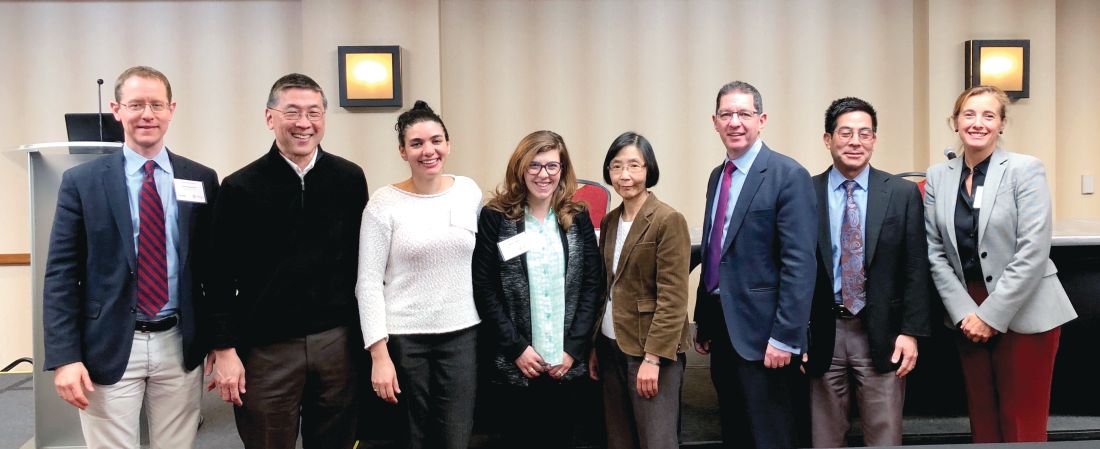
Clinical perspective from Sarah R. Lieber, MD
As a second-year gastroenterology fellow and aspiring transplant hepatologist, I found that this workshop provided an excellent framework and foundation for launching a career in academics and clinical research. It was especially effective at providing practical tips and tools for fellows and junior faculty on how to find an academic job, apply for research funding, and conduct written and oral presentations.
I was particularly moved by the personal stories and anecdotes from faculty members – many of whom are renowned leaders in the fields of GI and hepatology – who divulged the challenges and insecurities they had to overcome early in their careers. Sheila E. Crowe, MD, FRCPC, FACP, FACG, AGAF, gave an especially poignant talk on her career path from fellowship to becoming AGA president. She discussed the challenges unique to women in academic GI and hepatology, but left me feeling empowered and inspired by showcasing the many talents and success stories of her female colleagues and herself as well.
On Saturday, the AASLD held a special session that highlighted the personal stories and career trajectories of clinicians and researchers in the forefront of the field of hepatology – including AASLD president-elect Michael W. Fried, MD, FAASLD, and current AASLD President Ana Lok MD, FAASLD – among others. They emphasized the power of collaborative research that included harnessing the tools of molecular biology and Big Data to investigate the role of the microbiome and other novel subjects in liver disease. They advised us to seek out formal training when available, including master degrees or biostatistics training, to help us develop the skill sets necessary as independent researchers. They elaborated about their experiences serving on professional committees and giving oral presentations – essential to their career development – which allowed them to carve out a research niche and gain recognition as experts in their fields.
There were several powerful lessons and important themes that I take away from this workshop. The first is the importance of citizenship: Being a successful academician means not only putting in the clinical hours and being a prolific researcher but also being a good citizen. Supporting your colleagues, teaching mentees, and being a “team player” are all elements crucial to forming meaningful relationships and standing out as a valuable individual in your department. Second, perseverance is equally important; whether you are resubmitting applications for grant funding or reaching out to mentors in your area of interest, perseverance is the key to a successful career in academics. Third, remember that there is the important distinction between mentorship and sponsorship. While it is essential to have a selfless and supportive mentor who helps you cultivate your clinical and research interests, it is equally important to find a sponsor: an influential academician who can help you launch your career by acting as your advocate and opening doors to professional opportunities. Finally,you must always deliver. When mentors and sponsors give you opportunities to showcase your talents, always invest the time and effort to provide a high-quality performance. Be a good citizen who perseveres, seek out influential mentorship and sponsorship, and deliver on important professional tasks which will prime you to succeed as an academic clinical researcher in GI and hepatology.
Basic scientist perspective from Ana Maldonado-Contreras, PhD
The AGA-AASLD Workshop represented an ideal opportunity to regain perspective on my overall career plan. This year, Dr. Jung restructured the format of the program by substituting “lecture-style” sessions with fully interactive discussion panels in which trainees had the opportunity to initiate discussions about various topics of interest. The faculty leading these interactive sessions were committed to providing honest and clear answers to all of our questions. I believe this was a unique opportunity to go beyond PowerPoint presentations to actually gain insights on the dynamics of an academic department. We learned from department chairs what is considered during hiring, promoting, or allocating funds to make their team successful. Among the topics discussed, collegiality and selfless peer support were highlighted among the qualities of an appreciated department member. Panelists insisted that a balancing act between team support and one’s productivity is fundamental to thriving and maintaining focus.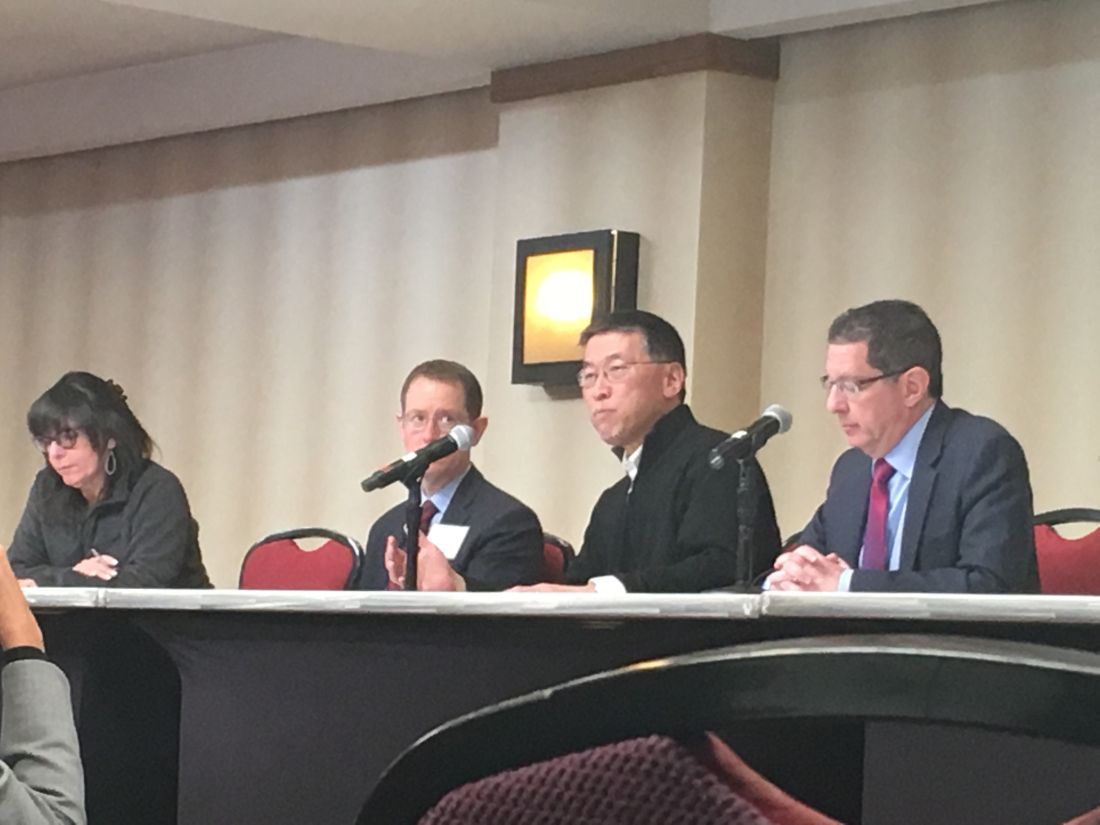
Another topic with personal relevance was securing funding for my newly formed laboratory – and I was not alone! Prior to the meeting, participants were divided into small groups and assigned to a faculty mentor. Each participant was asked to share a research proposal and CV with her respective mentor. Then, each group had the opportunity to meet during the afternoon mentoring sessions. My group was composed of four participants interested in learning more about National Institutes of Health (NIH) funding strategies based on our current situations. Our assigned mentor, John Inadomi, MD – who thoroughly read our proposals and knew who we were before our encounter – provided practical advice about grant mechanisms to pursue given our current positions and provided detailed tips for successful applications. Dr. Inadomi also was greatly insightful about NIH study sessions and the entire review process. This person-to-person interaction was extremely helpful as it opened the possibility of discussing singularities of each participant’s career plans. Similarly, on the next day we had face time with David Saslowsky, PhD, program director of the National Institute of Diabetes and Digestive and Kidney Diseases at NIH. Dr. Saslowsky also reviewed our research proposals and discussed potential venues for funding within the NIDDK based on individual career trajectories.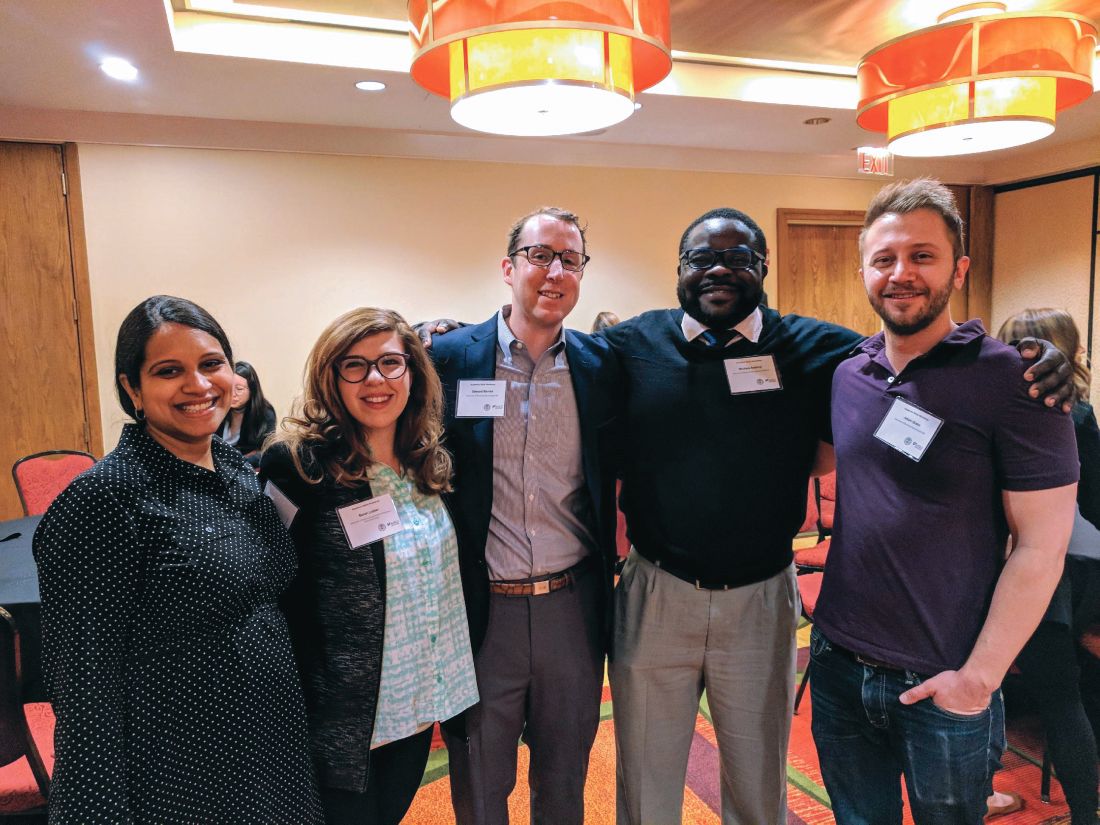
Most of the second day was dedicated to reviewing grant opportunities and pertinent tips on how to get funded. We discussed the “most common mistakes” made by junior faculty on grant applications and ways to avoid them. All panelists agreed that the most common mistake is overambition. They advised us to critically consider the aims and activities proposed and, more importantly, seek out advice from mentors with more experience in grant writing.
Undoubtedly, networking with other peers represented an essential part of the experience at this academic workshop. As trainees, we were able to connect with not only seasoned colleagues but also with peers facing the same career challenges. Senior faculty were amazingly personable and committed to sharing experiences with the next generation of clinicians and scientists. They shared their failures, frustrations, and fears as well as their successes. Each story and the words of encouragement from this great community of scientists and clinicians helped me realize my hidden strengths and how to build from my past accomplishments to excel on my path toward becoming a fully independent researcher.
Dr. Lieber is a clinical epidemiology fellow, department of medicine, division of gastroenterology and hepatology, University of North Carolina (UNC), Chapel Hill; Dr. Maldonado-Contreras is an instructor in the department of microbiology and physiological systems and the Center for Microbiome Research, University of Massachusetts, Worcester.
In March 2018, the American Gastroenterological Association (AGA) and American Association for the Study of Liver Diseases (AASLD) sponsored the Academic Skills Workshop in Charlotte, N.C. This year’s chairs Barbara Jung, MD, and Michael W. Fried, MD, FAASLD, as well as codirectors Marcia Cruz-Correa, MD, PhD, AGAF, FASGE, and Raymond Chung, MD, FAASLD, led a 2-day workshop featuring educational sessions and opportunities for mentorship and networking in academic gastroenterology and hepatology. The workshop featured sessions on how to navigate the job market, map out a career trajectory, develop fruitful mentoring relationships, apply for grant funding, and showcase research through manuscripts and oral presentations. Fellows and junior faculty from academic institutions across the United States were able to come together. Herein, two participants share their experiences at this event.

Clinical perspective from Sarah R. Lieber, MD
As a second-year gastroenterology fellow and aspiring transplant hepatologist, I found that this workshop provided an excellent framework and foundation for launching a career in academics and clinical research. It was especially effective at providing practical tips and tools for fellows and junior faculty on how to find an academic job, apply for research funding, and conduct written and oral presentations.
I was particularly moved by the personal stories and anecdotes from faculty members – many of whom are renowned leaders in the fields of GI and hepatology – who divulged the challenges and insecurities they had to overcome early in their careers. Sheila E. Crowe, MD, FRCPC, FACP, FACG, AGAF, gave an especially poignant talk on her career path from fellowship to becoming AGA president. She discussed the challenges unique to women in academic GI and hepatology, but left me feeling empowered and inspired by showcasing the many talents and success stories of her female colleagues and herself as well.
On Saturday, the AASLD held a special session that highlighted the personal stories and career trajectories of clinicians and researchers in the forefront of the field of hepatology – including AASLD president-elect Michael W. Fried, MD, FAASLD, and current AASLD President Ana Lok MD, FAASLD – among others. They emphasized the power of collaborative research that included harnessing the tools of molecular biology and Big Data to investigate the role of the microbiome and other novel subjects in liver disease. They advised us to seek out formal training when available, including master degrees or biostatistics training, to help us develop the skill sets necessary as independent researchers. They elaborated about their experiences serving on professional committees and giving oral presentations – essential to their career development – which allowed them to carve out a research niche and gain recognition as experts in their fields.
There were several powerful lessons and important themes that I take away from this workshop. The first is the importance of citizenship: Being a successful academician means not only putting in the clinical hours and being a prolific researcher but also being a good citizen. Supporting your colleagues, teaching mentees, and being a “team player” are all elements crucial to forming meaningful relationships and standing out as a valuable individual in your department. Second, perseverance is equally important; whether you are resubmitting applications for grant funding or reaching out to mentors in your area of interest, perseverance is the key to a successful career in academics. Third, remember that there is the important distinction between mentorship and sponsorship. While it is essential to have a selfless and supportive mentor who helps you cultivate your clinical and research interests, it is equally important to find a sponsor: an influential academician who can help you launch your career by acting as your advocate and opening doors to professional opportunities. Finally,you must always deliver. When mentors and sponsors give you opportunities to showcase your talents, always invest the time and effort to provide a high-quality performance. Be a good citizen who perseveres, seek out influential mentorship and sponsorship, and deliver on important professional tasks which will prime you to succeed as an academic clinical researcher in GI and hepatology.
Basic scientist perspective from Ana Maldonado-Contreras, PhD
The AGA-AASLD Workshop represented an ideal opportunity to regain perspective on my overall career plan. This year, Dr. Jung restructured the format of the program by substituting “lecture-style” sessions with fully interactive discussion panels in which trainees had the opportunity to initiate discussions about various topics of interest. The faculty leading these interactive sessions were committed to providing honest and clear answers to all of our questions. I believe this was a unique opportunity to go beyond PowerPoint presentations to actually gain insights on the dynamics of an academic department. We learned from department chairs what is considered during hiring, promoting, or allocating funds to make their team successful. Among the topics discussed, collegiality and selfless peer support were highlighted among the qualities of an appreciated department member. Panelists insisted that a balancing act between team support and one’s productivity is fundamental to thriving and maintaining focus.
Another topic with personal relevance was securing funding for my newly formed laboratory – and I was not alone! Prior to the meeting, participants were divided into small groups and assigned to a faculty mentor. Each participant was asked to share a research proposal and CV with her respective mentor. Then, each group had the opportunity to meet during the afternoon mentoring sessions. My group was composed of four participants interested in learning more about National Institutes of Health (NIH) funding strategies based on our current situations. Our assigned mentor, John Inadomi, MD – who thoroughly read our proposals and knew who we were before our encounter – provided practical advice about grant mechanisms to pursue given our current positions and provided detailed tips for successful applications. Dr. Inadomi also was greatly insightful about NIH study sessions and the entire review process. This person-to-person interaction was extremely helpful as it opened the possibility of discussing singularities of each participant’s career plans. Similarly, on the next day we had face time with David Saslowsky, PhD, program director of the National Institute of Diabetes and Digestive and Kidney Diseases at NIH. Dr. Saslowsky also reviewed our research proposals and discussed potential venues for funding within the NIDDK based on individual career trajectories.
Most of the second day was dedicated to reviewing grant opportunities and pertinent tips on how to get funded. We discussed the “most common mistakes” made by junior faculty on grant applications and ways to avoid them. All panelists agreed that the most common mistake is overambition. They advised us to critically consider the aims and activities proposed and, more importantly, seek out advice from mentors with more experience in grant writing.
Undoubtedly, networking with other peers represented an essential part of the experience at this academic workshop. As trainees, we were able to connect with not only seasoned colleagues but also with peers facing the same career challenges. Senior faculty were amazingly personable and committed to sharing experiences with the next generation of clinicians and scientists. They shared their failures, frustrations, and fears as well as their successes. Each story and the words of encouragement from this great community of scientists and clinicians helped me realize my hidden strengths and how to build from my past accomplishments to excel on my path toward becoming a fully independent researcher.
Dr. Lieber is a clinical epidemiology fellow, department of medicine, division of gastroenterology and hepatology, University of North Carolina (UNC), Chapel Hill; Dr. Maldonado-Contreras is an instructor in the department of microbiology and physiological systems and the Center for Microbiome Research, University of Massachusetts, Worcester.
In March 2018, the American Gastroenterological Association (AGA) and American Association for the Study of Liver Diseases (AASLD) sponsored the Academic Skills Workshop in Charlotte, N.C. This year’s chairs Barbara Jung, MD, and Michael W. Fried, MD, FAASLD, as well as codirectors Marcia Cruz-Correa, MD, PhD, AGAF, FASGE, and Raymond Chung, MD, FAASLD, led a 2-day workshop featuring educational sessions and opportunities for mentorship and networking in academic gastroenterology and hepatology. The workshop featured sessions on how to navigate the job market, map out a career trajectory, develop fruitful mentoring relationships, apply for grant funding, and showcase research through manuscripts and oral presentations. Fellows and junior faculty from academic institutions across the United States were able to come together. Herein, two participants share their experiences at this event.

Clinical perspective from Sarah R. Lieber, MD
As a second-year gastroenterology fellow and aspiring transplant hepatologist, I found that this workshop provided an excellent framework and foundation for launching a career in academics and clinical research. It was especially effective at providing practical tips and tools for fellows and junior faculty on how to find an academic job, apply for research funding, and conduct written and oral presentations.
I was particularly moved by the personal stories and anecdotes from faculty members – many of whom are renowned leaders in the fields of GI and hepatology – who divulged the challenges and insecurities they had to overcome early in their careers. Sheila E. Crowe, MD, FRCPC, FACP, FACG, AGAF, gave an especially poignant talk on her career path from fellowship to becoming AGA president. She discussed the challenges unique to women in academic GI and hepatology, but left me feeling empowered and inspired by showcasing the many talents and success stories of her female colleagues and herself as well.
On Saturday, the AASLD held a special session that highlighted the personal stories and career trajectories of clinicians and researchers in the forefront of the field of hepatology – including AASLD president-elect Michael W. Fried, MD, FAASLD, and current AASLD President Ana Lok MD, FAASLD – among others. They emphasized the power of collaborative research that included harnessing the tools of molecular biology and Big Data to investigate the role of the microbiome and other novel subjects in liver disease. They advised us to seek out formal training when available, including master degrees or biostatistics training, to help us develop the skill sets necessary as independent researchers. They elaborated about their experiences serving on professional committees and giving oral presentations – essential to their career development – which allowed them to carve out a research niche and gain recognition as experts in their fields.
There were several powerful lessons and important themes that I take away from this workshop. The first is the importance of citizenship: Being a successful academician means not only putting in the clinical hours and being a prolific researcher but also being a good citizen. Supporting your colleagues, teaching mentees, and being a “team player” are all elements crucial to forming meaningful relationships and standing out as a valuable individual in your department. Second, perseverance is equally important; whether you are resubmitting applications for grant funding or reaching out to mentors in your area of interest, perseverance is the key to a successful career in academics. Third, remember that there is the important distinction between mentorship and sponsorship. While it is essential to have a selfless and supportive mentor who helps you cultivate your clinical and research interests, it is equally important to find a sponsor: an influential academician who can help you launch your career by acting as your advocate and opening doors to professional opportunities. Finally,you must always deliver. When mentors and sponsors give you opportunities to showcase your talents, always invest the time and effort to provide a high-quality performance. Be a good citizen who perseveres, seek out influential mentorship and sponsorship, and deliver on important professional tasks which will prime you to succeed as an academic clinical researcher in GI and hepatology.
Basic scientist perspective from Ana Maldonado-Contreras, PhD
The AGA-AASLD Workshop represented an ideal opportunity to regain perspective on my overall career plan. This year, Dr. Jung restructured the format of the program by substituting “lecture-style” sessions with fully interactive discussion panels in which trainees had the opportunity to initiate discussions about various topics of interest. The faculty leading these interactive sessions were committed to providing honest and clear answers to all of our questions. I believe this was a unique opportunity to go beyond PowerPoint presentations to actually gain insights on the dynamics of an academic department. We learned from department chairs what is considered during hiring, promoting, or allocating funds to make their team successful. Among the topics discussed, collegiality and selfless peer support were highlighted among the qualities of an appreciated department member. Panelists insisted that a balancing act between team support and one’s productivity is fundamental to thriving and maintaining focus.
Another topic with personal relevance was securing funding for my newly formed laboratory – and I was not alone! Prior to the meeting, participants were divided into small groups and assigned to a faculty mentor. Each participant was asked to share a research proposal and CV with her respective mentor. Then, each group had the opportunity to meet during the afternoon mentoring sessions. My group was composed of four participants interested in learning more about National Institutes of Health (NIH) funding strategies based on our current situations. Our assigned mentor, John Inadomi, MD – who thoroughly read our proposals and knew who we were before our encounter – provided practical advice about grant mechanisms to pursue given our current positions and provided detailed tips for successful applications. Dr. Inadomi also was greatly insightful about NIH study sessions and the entire review process. This person-to-person interaction was extremely helpful as it opened the possibility of discussing singularities of each participant’s career plans. Similarly, on the next day we had face time with David Saslowsky, PhD, program director of the National Institute of Diabetes and Digestive and Kidney Diseases at NIH. Dr. Saslowsky also reviewed our research proposals and discussed potential venues for funding within the NIDDK based on individual career trajectories.
Most of the second day was dedicated to reviewing grant opportunities and pertinent tips on how to get funded. We discussed the “most common mistakes” made by junior faculty on grant applications and ways to avoid them. All panelists agreed that the most common mistake is overambition. They advised us to critically consider the aims and activities proposed and, more importantly, seek out advice from mentors with more experience in grant writing.
Undoubtedly, networking with other peers represented an essential part of the experience at this academic workshop. As trainees, we were able to connect with not only seasoned colleagues but also with peers facing the same career challenges. Senior faculty were amazingly personable and committed to sharing experiences with the next generation of clinicians and scientists. They shared their failures, frustrations, and fears as well as their successes. Each story and the words of encouragement from this great community of scientists and clinicians helped me realize my hidden strengths and how to build from my past accomplishments to excel on my path toward becoming a fully independent researcher.
Dr. Lieber is a clinical epidemiology fellow, department of medicine, division of gastroenterology and hepatology, University of North Carolina (UNC), Chapel Hill; Dr. Maldonado-Contreras is an instructor in the department of microbiology and physiological systems and the Center for Microbiome Research, University of Massachusetts, Worcester.
Upper GI tract
Rhonda Souza, MD, AGAF, started off this session with a review of eosinophilic esophagitis (EoE). She explained the challenges of the six-food elimination diet and described an alternative step-up elimination diet. In one study of the step-up elimination diet, food triggers were identified in 88% of patients during the reintroduction of food groups. Proton pump inhibitors are recommended for patients who do not respond to or refuse diet therapy; 30%-50% of patients with EoE will respond to the drugs. She explained that PPIs might have eosinophil-reducing effects independent of gastric acid–lowering effects, and said that PPIs should be stopped for 3-4 weeks before a diagnostic endoscopy is performed if EoE is suspected. Dr. Souza also spoke about topical steroids, biologic agents, and gradual esophageal dilation.
Ronnie Fass, MD, then addressed the management of patients with documented gastroesophageal reflux disease (GERD), or heartburn without documented GERD, who are unresponsive to PPIs. He referred to the management algorithm that he and Prakash Gyawali, MD, MRCP, published this year (Gastroenterology 2018;154:302-18), and described the optimization of PPI therapy before doubling the dose, as well as the testing that should be done if the dose increase does not relieve symptoms. Dr. Fass showed that there are various possible mechanisms for refractory GERD or heartburn, including weakly acidic or alkaline reflux, functional heartburn, and reflux hypersensitivity. He reviewed the Rome IV diagnostic criteria and treatment for the latter two conditions, and discussed the role of esophageal manometry to exclude esophageal motor disorders in patients with refractory GERD and heartburn.
Colin Howden, MD, AGAF, presented data on the risks and benefits of PPIs. He reviewed the Hill criteria to prove causation and methodically reviewed whether these criteria applied to various reported risks of PPIs, from C. difficile infection and bacterial gastroenteritis to kidney disease and interference with calcium absorption. He concluded that the absolute risks are low, that most data are retrospective and prone to bias, and that causality has generally not been demonstrated. Benefit usually outweighs risk if there is a valid indication for PPI use, he said, but the lowest effective dose should be used.
Jan Tack, MD, PhD, then reviewed functional dyspepsia (FD). He described the Rome IV criteria for FD and the two main subtypes of epigastric pain syndrome (EPS) and postprandial distress syndrome (PDS), noting that some patients have both. Dr. Tack then discussed the pathophysiologic mechanisms and treatment approaches. For EPS, he recommended a trial of PPIs, then tricyclic antidepressants, and for refractory cases, behavioral therapy. For PDS, he recommended a prokinetic agent if available or acid suppression. If no response, then a 5HT1A agonist such as buspirone can be used for early satiety or mirtazapine for those with weight loss. In refractory cases, he said, a prokinetic agent such as prucalopride can be considered if there is delayed gastric emptying.
Baharak Moshiree, MD, AGAF, discussed the causes, diagnosis, and treatment of chronic nausea. Gastrointestinal causes include FD, gastroparesis, irritable bowel syndrome, celiac disease, and small intestinal bacterial overgrowth. Dr. Moshiree outlined the Rome IV criteria for chronic nausea and vomiting syndrome, cyclic vomiting syndrome, and cannabinoid hyperemesis syndrome. She also described the overlap between FD and gastroparesis and noted that nausea is a common symptom of both. Various tests can be used to rule out structural GI causes and to measure motility and gastric accommodation. In addition to treatment such as antiemetics, prokinetic agents, and neuromodulators, Dr. Moshiree examined the evidence of emerging therapies such as aprepitant, an NK1 antagonist, for gastroparesis or unexplained chronic nausea and vomiting.
Barham Abu Dayyeh, MD, MPH, addressed endoscopic management of patients after bariatric surgery. He showed that hemorrhage or marginal ulcers postsurgery can be treated with PPIs, hemoclips for bleeding ulcers, and endoscopic suturing or surgery for recalcitrant ulcers. He also discussed the management of a stenosis after Roux-en-Y gastric bypass, which now includes lumen-opposing stents, as well as the management of leaks from sleeve gastrectomy and gastric bypass and the management of biliary complications. Lastly, he reviewed the modifiable risk factors for weight regain after Roux-en-Y gastric bypass, such as gastrogastric fistula and gastrojejunal stoma dilation, and how they can be endoscopically managed.
Dr. Chang is vice-chief, Vatche and Tamar Manoukian division of digestive diseases, program director, UCLA GI fellowship program, codirector, G. Oppenheimer Center for Neurobiology of Stress and Resilience, and professor of medicine at the David Geffen School of Medicine at UCLA. This is a summary provided by the moderator of one of the AGA Postgraduate Courses held at DDW 2018. She is on the advisory board for Synergy, IM HealthSciences, and Salix; an adviser for Metameconnect.com and ModifyHealth; and a speaker for Allergan and Takeda.
Rhonda Souza, MD, AGAF, started off this session with a review of eosinophilic esophagitis (EoE). She explained the challenges of the six-food elimination diet and described an alternative step-up elimination diet. In one study of the step-up elimination diet, food triggers were identified in 88% of patients during the reintroduction of food groups. Proton pump inhibitors are recommended for patients who do not respond to or refuse diet therapy; 30%-50% of patients with EoE will respond to the drugs. She explained that PPIs might have eosinophil-reducing effects independent of gastric acid–lowering effects, and said that PPIs should be stopped for 3-4 weeks before a diagnostic endoscopy is performed if EoE is suspected. Dr. Souza also spoke about topical steroids, biologic agents, and gradual esophageal dilation.
Ronnie Fass, MD, then addressed the management of patients with documented gastroesophageal reflux disease (GERD), or heartburn without documented GERD, who are unresponsive to PPIs. He referred to the management algorithm that he and Prakash Gyawali, MD, MRCP, published this year (Gastroenterology 2018;154:302-18), and described the optimization of PPI therapy before doubling the dose, as well as the testing that should be done if the dose increase does not relieve symptoms. Dr. Fass showed that there are various possible mechanisms for refractory GERD or heartburn, including weakly acidic or alkaline reflux, functional heartburn, and reflux hypersensitivity. He reviewed the Rome IV diagnostic criteria and treatment for the latter two conditions, and discussed the role of esophageal manometry to exclude esophageal motor disorders in patients with refractory GERD and heartburn.
Colin Howden, MD, AGAF, presented data on the risks and benefits of PPIs. He reviewed the Hill criteria to prove causation and methodically reviewed whether these criteria applied to various reported risks of PPIs, from C. difficile infection and bacterial gastroenteritis to kidney disease and interference with calcium absorption. He concluded that the absolute risks are low, that most data are retrospective and prone to bias, and that causality has generally not been demonstrated. Benefit usually outweighs risk if there is a valid indication for PPI use, he said, but the lowest effective dose should be used.
Jan Tack, MD, PhD, then reviewed functional dyspepsia (FD). He described the Rome IV criteria for FD and the two main subtypes of epigastric pain syndrome (EPS) and postprandial distress syndrome (PDS), noting that some patients have both. Dr. Tack then discussed the pathophysiologic mechanisms and treatment approaches. For EPS, he recommended a trial of PPIs, then tricyclic antidepressants, and for refractory cases, behavioral therapy. For PDS, he recommended a prokinetic agent if available or acid suppression. If no response, then a 5HT1A agonist such as buspirone can be used for early satiety or mirtazapine for those with weight loss. In refractory cases, he said, a prokinetic agent such as prucalopride can be considered if there is delayed gastric emptying.
Baharak Moshiree, MD, AGAF, discussed the causes, diagnosis, and treatment of chronic nausea. Gastrointestinal causes include FD, gastroparesis, irritable bowel syndrome, celiac disease, and small intestinal bacterial overgrowth. Dr. Moshiree outlined the Rome IV criteria for chronic nausea and vomiting syndrome, cyclic vomiting syndrome, and cannabinoid hyperemesis syndrome. She also described the overlap between FD and gastroparesis and noted that nausea is a common symptom of both. Various tests can be used to rule out structural GI causes and to measure motility and gastric accommodation. In addition to treatment such as antiemetics, prokinetic agents, and neuromodulators, Dr. Moshiree examined the evidence of emerging therapies such as aprepitant, an NK1 antagonist, for gastroparesis or unexplained chronic nausea and vomiting.
Barham Abu Dayyeh, MD, MPH, addressed endoscopic management of patients after bariatric surgery. He showed that hemorrhage or marginal ulcers postsurgery can be treated with PPIs, hemoclips for bleeding ulcers, and endoscopic suturing or surgery for recalcitrant ulcers. He also discussed the management of a stenosis after Roux-en-Y gastric bypass, which now includes lumen-opposing stents, as well as the management of leaks from sleeve gastrectomy and gastric bypass and the management of biliary complications. Lastly, he reviewed the modifiable risk factors for weight regain after Roux-en-Y gastric bypass, such as gastrogastric fistula and gastrojejunal stoma dilation, and how they can be endoscopically managed.
Dr. Chang is vice-chief, Vatche and Tamar Manoukian division of digestive diseases, program director, UCLA GI fellowship program, codirector, G. Oppenheimer Center for Neurobiology of Stress and Resilience, and professor of medicine at the David Geffen School of Medicine at UCLA. This is a summary provided by the moderator of one of the AGA Postgraduate Courses held at DDW 2018. She is on the advisory board for Synergy, IM HealthSciences, and Salix; an adviser for Metameconnect.com and ModifyHealth; and a speaker for Allergan and Takeda.
Rhonda Souza, MD, AGAF, started off this session with a review of eosinophilic esophagitis (EoE). She explained the challenges of the six-food elimination diet and described an alternative step-up elimination diet. In one study of the step-up elimination diet, food triggers were identified in 88% of patients during the reintroduction of food groups. Proton pump inhibitors are recommended for patients who do not respond to or refuse diet therapy; 30%-50% of patients with EoE will respond to the drugs. She explained that PPIs might have eosinophil-reducing effects independent of gastric acid–lowering effects, and said that PPIs should be stopped for 3-4 weeks before a diagnostic endoscopy is performed if EoE is suspected. Dr. Souza also spoke about topical steroids, biologic agents, and gradual esophageal dilation.
Ronnie Fass, MD, then addressed the management of patients with documented gastroesophageal reflux disease (GERD), or heartburn without documented GERD, who are unresponsive to PPIs. He referred to the management algorithm that he and Prakash Gyawali, MD, MRCP, published this year (Gastroenterology 2018;154:302-18), and described the optimization of PPI therapy before doubling the dose, as well as the testing that should be done if the dose increase does not relieve symptoms. Dr. Fass showed that there are various possible mechanisms for refractory GERD or heartburn, including weakly acidic or alkaline reflux, functional heartburn, and reflux hypersensitivity. He reviewed the Rome IV diagnostic criteria and treatment for the latter two conditions, and discussed the role of esophageal manometry to exclude esophageal motor disorders in patients with refractory GERD and heartburn.
Colin Howden, MD, AGAF, presented data on the risks and benefits of PPIs. He reviewed the Hill criteria to prove causation and methodically reviewed whether these criteria applied to various reported risks of PPIs, from C. difficile infection and bacterial gastroenteritis to kidney disease and interference with calcium absorption. He concluded that the absolute risks are low, that most data are retrospective and prone to bias, and that causality has generally not been demonstrated. Benefit usually outweighs risk if there is a valid indication for PPI use, he said, but the lowest effective dose should be used.
Jan Tack, MD, PhD, then reviewed functional dyspepsia (FD). He described the Rome IV criteria for FD and the two main subtypes of epigastric pain syndrome (EPS) and postprandial distress syndrome (PDS), noting that some patients have both. Dr. Tack then discussed the pathophysiologic mechanisms and treatment approaches. For EPS, he recommended a trial of PPIs, then tricyclic antidepressants, and for refractory cases, behavioral therapy. For PDS, he recommended a prokinetic agent if available or acid suppression. If no response, then a 5HT1A agonist such as buspirone can be used for early satiety or mirtazapine for those with weight loss. In refractory cases, he said, a prokinetic agent such as prucalopride can be considered if there is delayed gastric emptying.
Baharak Moshiree, MD, AGAF, discussed the causes, diagnosis, and treatment of chronic nausea. Gastrointestinal causes include FD, gastroparesis, irritable bowel syndrome, celiac disease, and small intestinal bacterial overgrowth. Dr. Moshiree outlined the Rome IV criteria for chronic nausea and vomiting syndrome, cyclic vomiting syndrome, and cannabinoid hyperemesis syndrome. She also described the overlap between FD and gastroparesis and noted that nausea is a common symptom of both. Various tests can be used to rule out structural GI causes and to measure motility and gastric accommodation. In addition to treatment such as antiemetics, prokinetic agents, and neuromodulators, Dr. Moshiree examined the evidence of emerging therapies such as aprepitant, an NK1 antagonist, for gastroparesis or unexplained chronic nausea and vomiting.
Barham Abu Dayyeh, MD, MPH, addressed endoscopic management of patients after bariatric surgery. He showed that hemorrhage or marginal ulcers postsurgery can be treated with PPIs, hemoclips for bleeding ulcers, and endoscopic suturing or surgery for recalcitrant ulcers. He also discussed the management of a stenosis after Roux-en-Y gastric bypass, which now includes lumen-opposing stents, as well as the management of leaks from sleeve gastrectomy and gastric bypass and the management of biliary complications. Lastly, he reviewed the modifiable risk factors for weight regain after Roux-en-Y gastric bypass, such as gastrogastric fistula and gastrojejunal stoma dilation, and how they can be endoscopically managed.
Dr. Chang is vice-chief, Vatche and Tamar Manoukian division of digestive diseases, program director, UCLA GI fellowship program, codirector, G. Oppenheimer Center for Neurobiology of Stress and Resilience, and professor of medicine at the David Geffen School of Medicine at UCLA. This is a summary provided by the moderator of one of the AGA Postgraduate Courses held at DDW 2018. She is on the advisory board for Synergy, IM HealthSciences, and Salix; an adviser for Metameconnect.com and ModifyHealth; and a speaker for Allergan and Takeda.
The large bowel, featuring side effects from checkpoint inhibitor therapy
The large bowel session focused on functional bowel complaints, colorectal cancer risk assessment, the management of serrated polyps, and finally, the spectrum of GI side effects resulting from checkpoint inhibitor therapy.
William Chey, MD, led with a review of novel topics in irritable bowel syndrome (IBS). He emphasized the growing influence of the microbiome considerations on current thinking about IBS, in addition to the more traditional concerns regarding altered motility, visceral perception, and brain-gut interaction. He presented data demonstrating the benefit of low-FODMAP and other diets, as well as the role of antibiotic therapy in selected patients. He also reviewed early data on fecal transplants for treating IBS.
Darren Brenner, MD, reviewed current guidelines for the management of chronic constipation. He emphasized the importance of early diagnostic testing for evacuation disorders as a possible explanation for chronic constipation (for example, anorectal manometry, balloon expulsion testing). He also suggested that earlier treatment with prescription-based agents may be warranted after failure of fiber or polyethylene glycol (PEG)–based laxatives. Finally, he discussed treatment options for constipation either induced or worsened by opioid exposure.
The role of serrated polyps in colorectal carcinogenesis has been increasingly recognized. Seth Crockett, MD, reviewed the optimal means for endoscopic recognition and removal of these lesions. Colonoscopy remains the gold standard to detect serrated polyps because stool tests (blood- and DNA-based) and computed tomography colonography typically have low sensitivities to detect these lesions.
Sapna Syngal, MD, discussed the growing role of gene panel testing for patients who have colorectal cancer (CRC) or who are at elevated risk. In most settings, all newly identified CRCs are tested for microsatellite instability – a characteristic of hereditary nonpolyposis colorectal cancer (Lynch syndrome). However, with the advent of less expensive multigene, blood-based screening tests, patients can be tested for a wide variety of genetic abnormalities, some that are typically associated with CRC and others that are not. Dr. Syngal emphasized the potential effects on immediate treatment, as well as risk stratification for other diseases, associated with broad mutation testing.
Finally, Edward Loftus, MD, reviewed the GI complications associated with checkpoint inhibitor therapy, a type of immunotherapy increasingly used for a wide range of cancers. These drugs cause colitis, hepatitis, and pancreatitis, among other adverse effects. Mild cases can typically be handled (usually as in outpatient settings) with oral steroids. However, more severe toxicities may require hospitalization and intravenous, high-dose steroids. Patients with colitis who fail steroids may require infliximab or other anti–tumor necrosis factor medications, while those with hepatitis may benefit from mycophenolate.
Dr. Weinberg is chairman of the department of medicine at Fox Chase Cancer Center, Philadelphia. He has no conflits of interest. This is a summary provided by the moderator of one of the AGA Postgraduate Courses held at DDW 2018.
The large bowel session focused on functional bowel complaints, colorectal cancer risk assessment, the management of serrated polyps, and finally, the spectrum of GI side effects resulting from checkpoint inhibitor therapy.
William Chey, MD, led with a review of novel topics in irritable bowel syndrome (IBS). He emphasized the growing influence of the microbiome considerations on current thinking about IBS, in addition to the more traditional concerns regarding altered motility, visceral perception, and brain-gut interaction. He presented data demonstrating the benefit of low-FODMAP and other diets, as well as the role of antibiotic therapy in selected patients. He also reviewed early data on fecal transplants for treating IBS.
Darren Brenner, MD, reviewed current guidelines for the management of chronic constipation. He emphasized the importance of early diagnostic testing for evacuation disorders as a possible explanation for chronic constipation (for example, anorectal manometry, balloon expulsion testing). He also suggested that earlier treatment with prescription-based agents may be warranted after failure of fiber or polyethylene glycol (PEG)–based laxatives. Finally, he discussed treatment options for constipation either induced or worsened by opioid exposure.
The role of serrated polyps in colorectal carcinogenesis has been increasingly recognized. Seth Crockett, MD, reviewed the optimal means for endoscopic recognition and removal of these lesions. Colonoscopy remains the gold standard to detect serrated polyps because stool tests (blood- and DNA-based) and computed tomography colonography typically have low sensitivities to detect these lesions.
Sapna Syngal, MD, discussed the growing role of gene panel testing for patients who have colorectal cancer (CRC) or who are at elevated risk. In most settings, all newly identified CRCs are tested for microsatellite instability – a characteristic of hereditary nonpolyposis colorectal cancer (Lynch syndrome). However, with the advent of less expensive multigene, blood-based screening tests, patients can be tested for a wide variety of genetic abnormalities, some that are typically associated with CRC and others that are not. Dr. Syngal emphasized the potential effects on immediate treatment, as well as risk stratification for other diseases, associated with broad mutation testing.
Finally, Edward Loftus, MD, reviewed the GI complications associated with checkpoint inhibitor therapy, a type of immunotherapy increasingly used for a wide range of cancers. These drugs cause colitis, hepatitis, and pancreatitis, among other adverse effects. Mild cases can typically be handled (usually as in outpatient settings) with oral steroids. However, more severe toxicities may require hospitalization and intravenous, high-dose steroids. Patients with colitis who fail steroids may require infliximab or other anti–tumor necrosis factor medications, while those with hepatitis may benefit from mycophenolate.
Dr. Weinberg is chairman of the department of medicine at Fox Chase Cancer Center, Philadelphia. He has no conflits of interest. This is a summary provided by the moderator of one of the AGA Postgraduate Courses held at DDW 2018.
The large bowel session focused on functional bowel complaints, colorectal cancer risk assessment, the management of serrated polyps, and finally, the spectrum of GI side effects resulting from checkpoint inhibitor therapy.
William Chey, MD, led with a review of novel topics in irritable bowel syndrome (IBS). He emphasized the growing influence of the microbiome considerations on current thinking about IBS, in addition to the more traditional concerns regarding altered motility, visceral perception, and brain-gut interaction. He presented data demonstrating the benefit of low-FODMAP and other diets, as well as the role of antibiotic therapy in selected patients. He also reviewed early data on fecal transplants for treating IBS.
Darren Brenner, MD, reviewed current guidelines for the management of chronic constipation. He emphasized the importance of early diagnostic testing for evacuation disorders as a possible explanation for chronic constipation (for example, anorectal manometry, balloon expulsion testing). He also suggested that earlier treatment with prescription-based agents may be warranted after failure of fiber or polyethylene glycol (PEG)–based laxatives. Finally, he discussed treatment options for constipation either induced or worsened by opioid exposure.
The role of serrated polyps in colorectal carcinogenesis has been increasingly recognized. Seth Crockett, MD, reviewed the optimal means for endoscopic recognition and removal of these lesions. Colonoscopy remains the gold standard to detect serrated polyps because stool tests (blood- and DNA-based) and computed tomography colonography typically have low sensitivities to detect these lesions.
Sapna Syngal, MD, discussed the growing role of gene panel testing for patients who have colorectal cancer (CRC) or who are at elevated risk. In most settings, all newly identified CRCs are tested for microsatellite instability – a characteristic of hereditary nonpolyposis colorectal cancer (Lynch syndrome). However, with the advent of less expensive multigene, blood-based screening tests, patients can be tested for a wide variety of genetic abnormalities, some that are typically associated with CRC and others that are not. Dr. Syngal emphasized the potential effects on immediate treatment, as well as risk stratification for other diseases, associated with broad mutation testing.
Finally, Edward Loftus, MD, reviewed the GI complications associated with checkpoint inhibitor therapy, a type of immunotherapy increasingly used for a wide range of cancers. These drugs cause colitis, hepatitis, and pancreatitis, among other adverse effects. Mild cases can typically be handled (usually as in outpatient settings) with oral steroids. However, more severe toxicities may require hospitalization and intravenous, high-dose steroids. Patients with colitis who fail steroids may require infliximab or other anti–tumor necrosis factor medications, while those with hepatitis may benefit from mycophenolate.
Dr. Weinberg is chairman of the department of medicine at Fox Chase Cancer Center, Philadelphia. He has no conflits of interest. This is a summary provided by the moderator of one of the AGA Postgraduate Courses held at DDW 2018.
Third-line avelumab for gastric cancer safer than chemotherapy
according to a recent study.
Although no primary or secondary endpoints were met, avelumab demonstrated similar antitumor activity compared with chemotherapy, reported Yung-Jue Bang, MD, PhD, of Seoul National University College of Medicine, South Korea, and his coauthors.
“There currently are no internationally recognized treatment guidelines for patients with advanced gastric cancer/gastroesophageal junction cancer [GC/GEJC] in whom two prior lines of therapy have failed,” the investigators wrote in Annals of Oncology.
The phase 3, randomized JAVELIN Gastric 300 trial compared avelumab, an anti–programmed death ligand 1 (PD-L1) monoclonal antibody, with physician’s choice of chemotherapy in 371 patients with metastatic GC/GEJC who had received two previous lines of systemic therapy. A total of 185 patients received avelumab and 186 patients received chemotherapy. Of those in the chemotherapy group, 120 (64.5%) were given irinotecan, 50 (29.0%) were given paclitaxel, and 3 (1.6%) received best supportive care only. The primary endpoint was overall survival, and secondary endpoints were objective response rate and progression-free survival. Safety and tolerability were also evaluated.
Neither primary nor secondary endpoints were met, and no significant difference in efficacy was found between treatment arms. However, tolerability was notably better in the avelumab treatment group. Treatment-related adverse events occurred in 90 patients (48.9%) in the avelumab group, compared with 131 patients (74.0%) in the chemotherapy group. Grade 3 or higher treatment-related adverse events were also less common in the avelumab group (9.2% vs. 31.6%). In the avelumab treatment arm, 4 patients (2.2%) had grade 3 or higher immune-related adverse events (autoimmune hypothyroidism, autoimmune hepatitis, elevated AST, and colitis).
“These results demonstrate that avelumab is better tolerated than chemotherapy in patients with heavily pretreated GC/GEJC, supporting the potential of avelumab for combination or maintenance therapy, even in later stages of disease,” the investigators wrote. “Nevertheless, the optimal strategy for incorporating checkpoint inhibitors into the continuum of care for patients with advanced GC/GEJC is still unknown, and studies of alternative anti–PD-1/PD-L1 treatment strategies in earlier lines of therapy are warranted.”
The study was funded by Merck and Pfizer. Authors reported compensation from AstraZeneca, Eli Lilly, Novartis, and others.
SOURCE: Bang YJ et al. Ann Oncol. 2018 Jul 24. doi:10.1093/annonc/mdy264.
according to a recent study.
Although no primary or secondary endpoints were met, avelumab demonstrated similar antitumor activity compared with chemotherapy, reported Yung-Jue Bang, MD, PhD, of Seoul National University College of Medicine, South Korea, and his coauthors.
“There currently are no internationally recognized treatment guidelines for patients with advanced gastric cancer/gastroesophageal junction cancer [GC/GEJC] in whom two prior lines of therapy have failed,” the investigators wrote in Annals of Oncology.
The phase 3, randomized JAVELIN Gastric 300 trial compared avelumab, an anti–programmed death ligand 1 (PD-L1) monoclonal antibody, with physician’s choice of chemotherapy in 371 patients with metastatic GC/GEJC who had received two previous lines of systemic therapy. A total of 185 patients received avelumab and 186 patients received chemotherapy. Of those in the chemotherapy group, 120 (64.5%) were given irinotecan, 50 (29.0%) were given paclitaxel, and 3 (1.6%) received best supportive care only. The primary endpoint was overall survival, and secondary endpoints were objective response rate and progression-free survival. Safety and tolerability were also evaluated.
Neither primary nor secondary endpoints were met, and no significant difference in efficacy was found between treatment arms. However, tolerability was notably better in the avelumab treatment group. Treatment-related adverse events occurred in 90 patients (48.9%) in the avelumab group, compared with 131 patients (74.0%) in the chemotherapy group. Grade 3 or higher treatment-related adverse events were also less common in the avelumab group (9.2% vs. 31.6%). In the avelumab treatment arm, 4 patients (2.2%) had grade 3 or higher immune-related adverse events (autoimmune hypothyroidism, autoimmune hepatitis, elevated AST, and colitis).
“These results demonstrate that avelumab is better tolerated than chemotherapy in patients with heavily pretreated GC/GEJC, supporting the potential of avelumab for combination or maintenance therapy, even in later stages of disease,” the investigators wrote. “Nevertheless, the optimal strategy for incorporating checkpoint inhibitors into the continuum of care for patients with advanced GC/GEJC is still unknown, and studies of alternative anti–PD-1/PD-L1 treatment strategies in earlier lines of therapy are warranted.”
The study was funded by Merck and Pfizer. Authors reported compensation from AstraZeneca, Eli Lilly, Novartis, and others.
SOURCE: Bang YJ et al. Ann Oncol. 2018 Jul 24. doi:10.1093/annonc/mdy264.
according to a recent study.
Although no primary or secondary endpoints were met, avelumab demonstrated similar antitumor activity compared with chemotherapy, reported Yung-Jue Bang, MD, PhD, of Seoul National University College of Medicine, South Korea, and his coauthors.
“There currently are no internationally recognized treatment guidelines for patients with advanced gastric cancer/gastroesophageal junction cancer [GC/GEJC] in whom two prior lines of therapy have failed,” the investigators wrote in Annals of Oncology.
The phase 3, randomized JAVELIN Gastric 300 trial compared avelumab, an anti–programmed death ligand 1 (PD-L1) monoclonal antibody, with physician’s choice of chemotherapy in 371 patients with metastatic GC/GEJC who had received two previous lines of systemic therapy. A total of 185 patients received avelumab and 186 patients received chemotherapy. Of those in the chemotherapy group, 120 (64.5%) were given irinotecan, 50 (29.0%) were given paclitaxel, and 3 (1.6%) received best supportive care only. The primary endpoint was overall survival, and secondary endpoints were objective response rate and progression-free survival. Safety and tolerability were also evaluated.
Neither primary nor secondary endpoints were met, and no significant difference in efficacy was found between treatment arms. However, tolerability was notably better in the avelumab treatment group. Treatment-related adverse events occurred in 90 patients (48.9%) in the avelumab group, compared with 131 patients (74.0%) in the chemotherapy group. Grade 3 or higher treatment-related adverse events were also less common in the avelumab group (9.2% vs. 31.6%). In the avelumab treatment arm, 4 patients (2.2%) had grade 3 or higher immune-related adverse events (autoimmune hypothyroidism, autoimmune hepatitis, elevated AST, and colitis).
“These results demonstrate that avelumab is better tolerated than chemotherapy in patients with heavily pretreated GC/GEJC, supporting the potential of avelumab for combination or maintenance therapy, even in later stages of disease,” the investigators wrote. “Nevertheless, the optimal strategy for incorporating checkpoint inhibitors into the continuum of care for patients with advanced GC/GEJC is still unknown, and studies of alternative anti–PD-1/PD-L1 treatment strategies in earlier lines of therapy are warranted.”
The study was funded by Merck and Pfizer. Authors reported compensation from AstraZeneca, Eli Lilly, Novartis, and others.
SOURCE: Bang YJ et al. Ann Oncol. 2018 Jul 24. doi:10.1093/annonc/mdy264.
FROM ANNALS OF ONCOLOGY
Key clinical point: Third-line avelumab for patients with gastric cancer is safer, but no more effective, than chemotherapy.
Major finding: Grade 3 or higher treatment-related adverse events occurred in 9.2% of patients treated with avelumab, compared with 31.6% of patients treated with chemotherapy.
Study details: The phase 3 JAVELIN Gastric 300 trial involved 371 patients with metastatic, nonresectable gastric cancer who had received two previous lines of systemic therapy.
Disclosures: The study was funded by Merck and Pfizer. Authors reported compensation from AstraZeneca, Eli Lilly, Novartis, and others.
Source: Bang YJ et al. Ann Oncol. 2018 Jul 24. doi:10.1093/annonc/mdy264.
Asthma medication ratio identifies high-risk pediatric patients
ATLANTA – An according to researchers from the Medical University of South Carolina (MUSC), Charleston.
The asthma medication ratio (AMR) – the number of prescriptions for controller medications divided by the number of prescriptions for both controller and rescue medications – has been around for a while, but it’s mostly been used as a quality metric. The new study shows that it’s also useful in the clinic to identify children who could benefit from extra attention.
A perfect ratio of 1 means that control is good without rescue inhalers. The ratio falls as the number of rescue inhalers goes up, signaling poorer control. Children with a ratio below 0.5 are considered high risk; they’d hit that mark if, for instance, they were prescribed one control medication such as fluticasone propionate (Flovent) and two albuterol rescue inhalers in a month.
If control is good, “you should only need a rescue inhaler very, very sporadically;” high-risk children probably need a higher dose of their controller, or help with compliance, explained lead investigator Annie L. Andrews, MD, associate professor of pediatrics at MUSC.
The university uses the EPIC records system, which incorporates prescription data from Surescripts, so the number of asthma medication fills is already available. The system just needs to be adjusted to calculate and report AMRs monthly, something Dr. Andrews and her team are working on. “The information is right there, but it’s an untapped resource,” she said. “We just need to crunch the numbers, and operationalize it. Why are we waiting until kids are in the hospital” to intervene?
Dr. Andrews presented a proof-of-concept study at the Pediatric Hospital Medicine meeting. Her team identified 214,452 asthma patients aged 2-17 years with at least one claim for an inhaled corticosteroid in the Truven MarketScan Medicaid database from 2013-14.
They calculated AMRs for each child every 3 months over a 15-month period. About 9% of children at any given time had AMRs below 0.5.
The first AMR was at or above 0.5 in 93,512 children; 18.1% had a subsequent asthma-related event, meaning an ED visit or hospitalization, during the course of the study. Among the 17,635 children with an initial AMR below 0.5, 25% had asthma-related events. The initial AMR couldn’t be calculated in 103,305 children, which likely meant they had less-active disease. Those children had the lowest proportion of asthma events, at 13.9%.
An AMR below 0.5 nearly doubled the risk of an asthma-related hospitalization or ED visit in the subsequent 3 months, with an odds ratios ranging from 1.7 to 1.9, compared with other children. The findings were statistically significant.
In short, serial AMRs helped predict exacerbations among Medicaid children. The team showed the same trend among commercially insured children in a recently published study. The only difference was that Medicaid children had a higher proportion of high-risk AMRs, and a higher number of asthma events (Am J Manag Care. 2018 Jun;24[6]:294-300). Together, the studies validate “the rolling 3-month AMR as an appropriate method for identifying children at high risk for imminent exacerbation,” the investigators concluded.
With automatic AMR reporting already in the works at MUSC, “we are now trying to figure out how to intervene. Do we just tell providers who their high-risk kids are and let them figure out how to contact families, or do we use this information to contact families directly? That’s kind of what I favor: ‘Hey, your kid just popped up as high risk, so let’s figure out what you need. Do you need a new prescription or a reminder to see your doctor?’ ” Dr. Andrews said.
Her team is developing a mobile app to communicate with families.
The mean age in the study was 7.9 years; 59% of the children were boys, and 41% were black.
The work was funded by the National Institutes of Health, among others. Dr. Andrews had no disclosures. The meeting was sponsored by the Society of Hospital Medicine, the American Academy of Pediatrics, and the Academic Pediatric Association.
ATLANTA – An according to researchers from the Medical University of South Carolina (MUSC), Charleston.
The asthma medication ratio (AMR) – the number of prescriptions for controller medications divided by the number of prescriptions for both controller and rescue medications – has been around for a while, but it’s mostly been used as a quality metric. The new study shows that it’s also useful in the clinic to identify children who could benefit from extra attention.
A perfect ratio of 1 means that control is good without rescue inhalers. The ratio falls as the number of rescue inhalers goes up, signaling poorer control. Children with a ratio below 0.5 are considered high risk; they’d hit that mark if, for instance, they were prescribed one control medication such as fluticasone propionate (Flovent) and two albuterol rescue inhalers in a month.
If control is good, “you should only need a rescue inhaler very, very sporadically;” high-risk children probably need a higher dose of their controller, or help with compliance, explained lead investigator Annie L. Andrews, MD, associate professor of pediatrics at MUSC.
The university uses the EPIC records system, which incorporates prescription data from Surescripts, so the number of asthma medication fills is already available. The system just needs to be adjusted to calculate and report AMRs monthly, something Dr. Andrews and her team are working on. “The information is right there, but it’s an untapped resource,” she said. “We just need to crunch the numbers, and operationalize it. Why are we waiting until kids are in the hospital” to intervene?
Dr. Andrews presented a proof-of-concept study at the Pediatric Hospital Medicine meeting. Her team identified 214,452 asthma patients aged 2-17 years with at least one claim for an inhaled corticosteroid in the Truven MarketScan Medicaid database from 2013-14.
They calculated AMRs for each child every 3 months over a 15-month period. About 9% of children at any given time had AMRs below 0.5.
The first AMR was at or above 0.5 in 93,512 children; 18.1% had a subsequent asthma-related event, meaning an ED visit or hospitalization, during the course of the study. Among the 17,635 children with an initial AMR below 0.5, 25% had asthma-related events. The initial AMR couldn’t be calculated in 103,305 children, which likely meant they had less-active disease. Those children had the lowest proportion of asthma events, at 13.9%.
An AMR below 0.5 nearly doubled the risk of an asthma-related hospitalization or ED visit in the subsequent 3 months, with an odds ratios ranging from 1.7 to 1.9, compared with other children. The findings were statistically significant.
In short, serial AMRs helped predict exacerbations among Medicaid children. The team showed the same trend among commercially insured children in a recently published study. The only difference was that Medicaid children had a higher proportion of high-risk AMRs, and a higher number of asthma events (Am J Manag Care. 2018 Jun;24[6]:294-300). Together, the studies validate “the rolling 3-month AMR as an appropriate method for identifying children at high risk for imminent exacerbation,” the investigators concluded.
With automatic AMR reporting already in the works at MUSC, “we are now trying to figure out how to intervene. Do we just tell providers who their high-risk kids are and let them figure out how to contact families, or do we use this information to contact families directly? That’s kind of what I favor: ‘Hey, your kid just popped up as high risk, so let’s figure out what you need. Do you need a new prescription or a reminder to see your doctor?’ ” Dr. Andrews said.
Her team is developing a mobile app to communicate with families.
The mean age in the study was 7.9 years; 59% of the children were boys, and 41% were black.
The work was funded by the National Institutes of Health, among others. Dr. Andrews had no disclosures. The meeting was sponsored by the Society of Hospital Medicine, the American Academy of Pediatrics, and the Academic Pediatric Association.
ATLANTA – An according to researchers from the Medical University of South Carolina (MUSC), Charleston.
The asthma medication ratio (AMR) – the number of prescriptions for controller medications divided by the number of prescriptions for both controller and rescue medications – has been around for a while, but it’s mostly been used as a quality metric. The new study shows that it’s also useful in the clinic to identify children who could benefit from extra attention.
A perfect ratio of 1 means that control is good without rescue inhalers. The ratio falls as the number of rescue inhalers goes up, signaling poorer control. Children with a ratio below 0.5 are considered high risk; they’d hit that mark if, for instance, they were prescribed one control medication such as fluticasone propionate (Flovent) and two albuterol rescue inhalers in a month.
If control is good, “you should only need a rescue inhaler very, very sporadically;” high-risk children probably need a higher dose of their controller, or help with compliance, explained lead investigator Annie L. Andrews, MD, associate professor of pediatrics at MUSC.
The university uses the EPIC records system, which incorporates prescription data from Surescripts, so the number of asthma medication fills is already available. The system just needs to be adjusted to calculate and report AMRs monthly, something Dr. Andrews and her team are working on. “The information is right there, but it’s an untapped resource,” she said. “We just need to crunch the numbers, and operationalize it. Why are we waiting until kids are in the hospital” to intervene?
Dr. Andrews presented a proof-of-concept study at the Pediatric Hospital Medicine meeting. Her team identified 214,452 asthma patients aged 2-17 years with at least one claim for an inhaled corticosteroid in the Truven MarketScan Medicaid database from 2013-14.
They calculated AMRs for each child every 3 months over a 15-month period. About 9% of children at any given time had AMRs below 0.5.
The first AMR was at or above 0.5 in 93,512 children; 18.1% had a subsequent asthma-related event, meaning an ED visit or hospitalization, during the course of the study. Among the 17,635 children with an initial AMR below 0.5, 25% had asthma-related events. The initial AMR couldn’t be calculated in 103,305 children, which likely meant they had less-active disease. Those children had the lowest proportion of asthma events, at 13.9%.
An AMR below 0.5 nearly doubled the risk of an asthma-related hospitalization or ED visit in the subsequent 3 months, with an odds ratios ranging from 1.7 to 1.9, compared with other children. The findings were statistically significant.
In short, serial AMRs helped predict exacerbations among Medicaid children. The team showed the same trend among commercially insured children in a recently published study. The only difference was that Medicaid children had a higher proportion of high-risk AMRs, and a higher number of asthma events (Am J Manag Care. 2018 Jun;24[6]:294-300). Together, the studies validate “the rolling 3-month AMR as an appropriate method for identifying children at high risk for imminent exacerbation,” the investigators concluded.
With automatic AMR reporting already in the works at MUSC, “we are now trying to figure out how to intervene. Do we just tell providers who their high-risk kids are and let them figure out how to contact families, or do we use this information to contact families directly? That’s kind of what I favor: ‘Hey, your kid just popped up as high risk, so let’s figure out what you need. Do you need a new prescription or a reminder to see your doctor?’ ” Dr. Andrews said.
Her team is developing a mobile app to communicate with families.
The mean age in the study was 7.9 years; 59% of the children were boys, and 41% were black.
The work was funded by the National Institutes of Health, among others. Dr. Andrews had no disclosures. The meeting was sponsored by the Society of Hospital Medicine, the American Academy of Pediatrics, and the Academic Pediatric Association.
REPORTING FROM PHM 2018
Key clinical point: The asthma medication ratio is useful in the clinic to identify children who could benefit from extra attention.
Major finding: About 9% of children at any given time had AMRs below 0.5, meaning they were at high risk for acute exacerbations.
Study details: Review of more than 200,000 pediatric asthma patients on Medicaid
Disclosures: The work was funded by the National Institutes of Health, among others. The study lead had no disclosures.
